Abraham Lincoln
| Abraham Lincoln | |
|---|---|
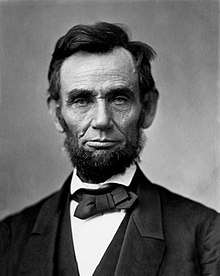 President Lincoln in November 1863 | |
| 16th President of the United States | |
|
In office March 4, 1861 – April 15, 1865 | |
| Vice President |
Hannibal Hamlin (1861–65) Andrew Johnson (1865) |
| Preceded by | James Buchanan |
| Succeeded by | Andrew Johnson |
| Member of the U.S. House of Representatives from Illinois's 7th district | |
|
In office March 4, 1847 – March 3, 1849 | |
| Preceded by | John Henry |
| Succeeded by | Thomas L. Harris |
| Member of the Illinois House of Representatives | |
|
In office 1834–1842 | |
| Personal details | |
| Born |
February 12, 1809 Sinking Spring Farm, near Hodgenville, Kentucky, U.S. |
| Died |
April 15, 1865 (aged 56) Petersen House, Washington, D.C., U.S. |
| Cause of death | Assassination |
| Resting place |
Lincoln Tomb, Oak Ridge Cemetery, Springfield, Illinois, U.S. |
| Political party |
Whig (1834–54) Republican (1854–64) |
| Other political affiliations | National Union (1864–65) |
| Height | 6 ft 4 in (193 cm)[1] |
| Spouse(s) | |
| Children |
Robert Lincoln Edward Lincoln Willie Lincoln Tad Lincoln |
| Parents |
Thomas Lincoln Nancy Hanks |
| Profession | Lawyer, politician |
| Signature |
|
| Military service | |
| Nickname(s) | Honest Abe |
| Allegiance |
|
| Service/branch | Illinois Militia |
| Years of service |
3 months (April 21, 1832 – July 10, 1832) |
| Rank |
|
| Battles/wars | Black Hawk War |
| ||
|---|---|---|
|
President of the United States
First term
Second term
Assassination and legacy
 |
||
Abraham Lincoln (February 12, 1809 – April 15, 1865) was an American statesman and lawyer who served as the 16th President of the United States from March 1861 until his assassination in April 1865. Lincoln led the United States through the American Civil War—its bloodiest war and perhaps its greatest moral, constitutional, and political crisis.[2][3] In doing so, he preserved the Union, abolished slavery, strengthened the federal government, and modernized the economy.
Born in Hodgenville, Kentucky, Lincoln grew up on the western frontier in Kentucky and Indiana. Largely self-educated, he became a lawyer in Illinois, a Whig Party leader, and was elected to the Illinois House of Representatives, in which he served for eight years. Elected to the United States House of Representatives in 1846, Lincoln promoted rapid modernization of the economy and opposed the Mexican–American War. After a single term, he returned to Illinois and resumed his successful law practice. Reentering politics in 1854, he became a leader in building the new Republican Party, which had a statewide majority in Illinois. As part of the 1858 campaign for US Senator from Illinois, Lincoln took part in a series of highly publicized debates with his opponent and rival, Democrat Stephen A. Douglas; Lincoln spoke out against the expansion of slavery, but lost the race to Douglas. In 1860, Lincoln secured the Republican Party presidential nomination as a moderate from a swing state, though most delegates originally favored other candidates. Though he gained very little support in the slaveholding states of the South, he swept the North and was elected president in 1860.
Though there were attempts to bridge the differences between North and South, ultimately Lincoln's victory prompted seven southern slave states to secede from the United States and form the Confederate States of America before he moved into the White House. U.S. troops refused to leave Fort Sumter, a fort located in Charleston, South Carolina, after the secession of the Southern States. The resulting Confederate attack on Fort Sumter inspired the North to rally behind the Union. As the leader of the moderate faction of the Republican Party, Lincoln confronted Radical Republicans, who demanded harsher treatment of the South; War Democrats, who rallied a large faction of former opponents into his camp; anti-war Democrats (called Copperheads), who despised him; and irreconcilable secessionists, who plotted his assassination. Lincoln fought back by pitting his opponents against each other, by carefully planned political patronage and by appealing to the American people with his powers of oratory.[4] His Gettysburg Address became an iconic endorsement of nationalism, republicanism, equal rights, liberty, and democracy. He suspended habeas corpus, leading to the controversial Ex parte Merryman decision, and he averted potential British intervention by defusing the Trent Affair. Lincoln closely supervised the war effort, especially the selection of generals, including his most successful general, Ulysses S. Grant. He made major decisions on Union war strategy, including a naval blockade that shut down the South's trade. As the war progressed, his complex moves toward ending slavery included the Emancipation Proclamation of 1863; Lincoln used the U.S. Army to protect escaped slaves, encouraged the border states to outlaw slavery, and pushed through Congress the Thirteenth Amendment to the United States Constitution, which permanently outlawed slavery.
An astute politician deeply involved with power issues in each state, Lincoln reached out to the War Democrats and managed his own re-election campaign in the 1864 presidential election. Anticipating the war's conclusion, Lincoln pushed a moderate view of Reconstruction, seeking to reunite the nation speedily through a policy of generous reconciliation in the face of lingering and bitter divisiveness. On April 14, 1865, five days after the surrender of Confederate general Robert E. Lee, Lincoln was shot by Confederate sympathizer John Wilkes Booth and died the next day. Lincoln has been consistently ranked both by scholars[5] and the public[6] as among the greatest U.S. presidents.
Family and childhood
Early life and ancestry
Abraham Lincoln was born on February 12, 1809, as the second child of Thomas and Nancy Hanks Lincoln, in a one-room log cabin on the Sinking Spring Farm near Hodgenville, Kentucky.[7] He was a descendant of Samuel Lincoln, an Englishman who migrated from Hingham, Norfolk, to its namesake of Hingham, Massachusetts, in 1638. Samuel's grandson and great-grandson began the family's western migration, which passed through New Jersey, Pennsylvania, and Virginia.[8][9] Lincoln's paternal grandfather and namesake, Captain Abraham Lincoln, moved the family from Virginia to Jefferson County, Kentucky, in the 1780s.[10] Captain Lincoln was killed in an Indian raid in 1786. His children, including eight-year-old Thomas,[12] the future president's father, witnessed the attack.[13][14][15] After his father's murder, Thomas was left to make his own way on the frontier, working at odd jobs in Kentucky and in Tennessee, before settling with members of his family in Hardin County, Kentucky, in the early 1800s.[16][17]
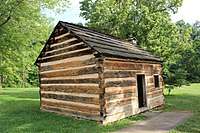
Lincoln's mother, Nancy, is widely assumed to have been the daughter of Lucy Hanks, although no record of Nancy Hanks' birth has ever been found.[18] According to William Ensign Lincoln's book The Ancestry of Abraham Lincoln, Nancy was the daughter of Joseph Hanks;[19] however, the debate continues over whether she was born out of wedlock. Still another researcher, Adin Baber, claims that Nancy Hanks was the daughter of Abraham Hanks and Sarah Harper of Virginia.[20]
Thomas Lincoln and Nancy Hanks were married on June 12, 1806, in Washington County, and moved to Elizabethtown, Kentucky, following their marriage.[21] They became the parents of three children: Sarah, born on February 10, 1807; Abraham, on February 12, 1809; and another son, Thomas, who died in infancy.[22] Thomas Lincoln bought or leased several farms in Kentucky, including the Sinking Spring farm, where Abraham was born; however, a land title dispute soon forced the Lincolns to move.[23][24] In 1811, the family moved eight miles (13 km) north, to Knob Creek Farm, where Thomas acquired title to 230 acres (93 ha) of land. In 1815 a claimant in another land dispute sought to eject the family from the farm.[24] Of the 816.5 acres (330.4 ha) that Thomas held in Kentucky, he lost all but 200 acres (81 ha) of his land in court disputes over property titles.[25] Frustrated over the lack of security provided by the Kentucky title survey system in the courts, Thomas sold the remaining land he held in Kentucky in 1814, and began planning a move to Indiana, where the land survey process was more reliable and the ability for an individual to retain land titles was more secure.[26]
In 1816, the family moved north across the Ohio River to Indiana, a free, non-slaveholding territory, where they settled in an "unbroken forest"[27] in Hurricane Township, Perry County. (Their land in southern Indiana became part of Spencer County, Indiana, when the county was established in 1818.)[28][29] The farm is preserved as part of the Lincoln Boyhood National Memorial. In 1860, Lincoln noted that the family's move to Indiana was "partly on account of slavery"; but mainly due to land title difficulties in Kentucky.[25][30] During the family's years in Kentucky and Indiana, Thomas Lincoln worked as a farmer, cabinetmaker, and carpenter.[31] He owned farms, several town lots and livestock, paid taxes, sat on juries, appraised estates, served on country slave patrols, and guarded prisoners. Thomas and Nancy Lincoln were also members of a Separate Baptists church, which had restrictive moral standards and opposed alcohol, dancing, and slavery.[32] Within a year of the family's arrival in Indiana, Thomas claimed title to 160 acres (65 ha) of Indiana land. Despite some financial challenges he eventually obtained clear title to 80 acres (32 ha) of land in what became known as the Little Pigeon Creek Community in Spencer County.[33] Prior to the family's move to Illinois in 1830, Thomas had acquired an additional twenty acres of land adjacent to his property.[34]
Several significant family events took place during Lincoln's youth in Indiana. On October 5, 1818, Nancy Lincoln died of milk sickness, leaving eleven-year-old Sarah in charge of a household that included her father, nine-year-old Abraham, and Dennis Hanks, Nancy's nineteen-year-old orphaned cousin.[35] On December 2, 1819, Lincoln's father married Sarah "Sally" Bush Johnston, a widow from Elizabethtown, Kentucky, with three children of her own.[36] Abraham became very close to his stepmother, whom he referred to as "Mother".[37][38] Those who knew Lincoln as a teenager later recalled him being very distraught over his sister Sarah's death on January 20, 1828, while giving birth to a stillborn son.[39][40]
As a youth, Lincoln disliked the hard labor associated with frontier life. Some of his neighbors and family members thought for a time that he was lazy for all his "reading, scribbling, writing, ciphering, writing Poetry, etc.",[41][42][43] and must have done it to avoid manual labor. His stepmother also acknowledged he did not enjoy "physical labor", but loved to read.[44] Lincoln was largely self-educated. His formal schooling from several itinerant teachers was intermittent, the aggregate of which may have amounted to less than a year; however, he was an avid reader and retained a lifelong interest in learning.[45][46] Family, neighbors, and schoolmates of Lincoln's youth recalled that he read and reread the King James Bible, Aesop's Fables, John Bunyan's The Pilgrim's Progress, Daniel Defoe's Robinson Crusoe, Mason Locke Weems's The Life of Washington, and The Autobiography of Benjamin Franklin, among others.[47][48][49][50]
As he grew into his teens, Lincoln took responsibility for the chores expected of him as one of the boys in the household. He also complied with the customary obligation of a son giving his father all earnings from work done outside the home until the age of twenty-one.[51] Abraham became adept at using an axe. Tall for his age, Lincoln was also strong and athletic.[52] He attained a reputation for brawn and audacity after a very competitive wrestling match with the renowned leader of a group of ruffians known as "the Clary's Grove boys".[53]
In early March 1830, partly out of fear of a milk sickness outbreak along the Ohio River, several members of the extended Lincoln family moved west to Illinois, a non-slaveholding state, and settled in Macon County, 10 miles (16 km) west of Decatur.[54][55] Historians disagree on who initiated the move; Thomas Lincoln had no obvious reason to leave Indiana, and one possibility is that other members of the family, including Dennis Hanks, might not have attained the stability and steady income that Thomas Lincoln had.[56] After the family relocated to Illinois, Abraham became increasingly distant from his father,[57] in part because of his father's lack of education, but occasionally lent him money.[58] In 1831, as Thomas and other members of the family prepared to move to a new homestead in Coles County, Illinois, Abraham was old enough to make his own decisions and struck out on his own.[59] Traveling down the Sangamon River, he ended up in the village of New Salem in Sangamon County.[60] Later that spring, Denton Offutt, a New Salem merchant, hired Lincoln and some friends to take goods by flatboat from New Salem to New Orleans via the Sangamon, Illinois, and Mississippi rivers. After arriving in New Orleans—and witnessing slavery firsthand—Lincoln returned to New Salem, where he remained for the next six years.[61][62]
Marriage and children
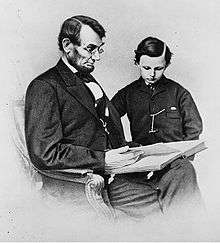
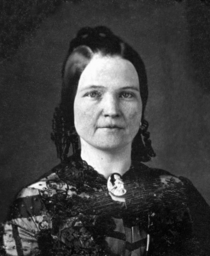
According to some sources, Lincoln's first romantic interest was Ann Rutledge, whom he met when he first moved to New Salem; these sources indicate that by 1835, they were in a relationship but not formally engaged.[63] She died at the age of 22 on August 25, 1835, most likely of typhoid fever.[64] In the early 1830s, he met Mary Owens from Kentucky when she was visiting her sister.[65]
Late in 1836, Lincoln agreed to a match with Mary if she returned to New Salem. Mary did return in November 1836, and Lincoln courted her for a time; however, they both had second thoughts about their relationship. On August 16, 1837, Lincoln wrote Mary a letter suggesting he would not blame her if she ended the relationship. She never replied and the courtship ended.[65]
In 1840, Lincoln became engaged to Mary Todd, who was from a wealthy slave-holding family in Lexington, Kentucky.[66] They met in Springfield, Illinois in December 1839[67] and were engaged the following December.[68] A wedding set for January 1, 1841, was canceled when the two broke off their engagement at Lincoln's initiative.[67][69] They later met again at a party and married on November 4, 1842, in the Springfield mansion of Mary's married sister.[70] While preparing for the nuptials and feeling anxiety again, Lincoln, when asked where he was going, replied, "To hell, I suppose."[71] In 1844, the couple bought a house in Springfield near Lincoln's law office. Mary Todd Lincoln kept house, often with the help of a relative or hired servant girl.[72]
He was an affectionate, though often absent, husband and father of four children. Robert Todd Lincoln was born in 1843 and Edward Baker Lincoln (Eddie) in 1846. Edward died on February 1, 1850, in Springfield, probably of tuberculosis. "Willie" Lincoln was born on December 21, 1850, and died of a fever on February 20, 1862. The Lincolns' fourth son, Thomas "Tad" Lincoln, was born on April 4, 1853, and died of heart failure at the age of 18 on July 16, 1871.[73] Robert was the only child to live to adulthood and have children. The Lincolns' last descendant, great-grandson Robert Todd Lincoln Beckwith, died in 1985.[74] Lincoln "was remarkably fond of children",[75] and the Lincolns were not considered to be strict with their own.[76]
The deaths of their sons had profound effects on both parents. Abraham Lincoln suffered from "melancholy", a condition which now is referred to as clinical depression.[77] Later in life, Mary struggled with the stresses of losing her husband and sons, and Robert Lincoln committed her temporarily to a mental health asylum in 1875.[78]
Lincoln's father-in-law and others of the Todd family were either slave owners or slave traders. Lincoln was close to the Todds, and he and his family occasionally visited the Todd estate in Lexington.[79]
During his term as President of the United States, Mary was known to cook for Lincoln often. Since she was raised by a wealthy family, her cooking abilities were simple, but satisfied Lincoln's tastes, which included, particularly, imported oysters.[80]
Early career and militia service

In 1832, at age 23, Lincoln and a partner (Denton Offutt) bought a small general store on credit in New Salem, Illinois.[81] Although the economy was booming in the region, the business struggled and Lincoln eventually sold his share. That March he began his political career with his first campaign for the Illinois General Assembly. He had attained local popularity and could draw crowds as a natural raconteur in New Salem, though he lacked an education, powerful friends, and money, which may be why he lost. He advocated navigational improvements on the Sangamon River.[82][83]
Before the election, Lincoln served as a captain in the Illinois Militia during the Black Hawk War.[84] Following his return, Lincoln continued his campaign for the August 6 election for the Illinois General Assembly. At 6 feet 4 inches (193 cm),[85] he was tall and "strong enough to intimidate any rival". At his first speech, when he saw a supporter in the crowd being attacked, Lincoln grabbed the assailant by his "neck and the seat of his trousers" and threw him.[86] Lincoln finished eighth out of 13 candidates (the top four were elected), though he received 277 of the 300 votes cast in the New Salem precinct.[87]
Lincoln served as New Salem's postmaster and later as county surveyor, all the while reading voraciously. He then decided to become a lawyer and began teaching himself law by reading Blackstone's Commentaries on the Laws of England and other law books. Of his learning method, Lincoln stated: "I studied with nobody".[88] His second campaign in 1834 was successful. He won election to the state legislature; though he ran as a Whig, many Democrats favored him over a more powerful Whig opponent.[89]
Admitted to the Illinois bar in 1836,[90] he moved to Springfield, Illinois, and began to practice law under John T. Stuart, Mary Todd's cousin.[91] Lincoln became an able and successful lawyer with a reputation as a formidable adversary during cross-examinations and closing arguments. He partnered with Stephen T. Logan from 1841 until 1844. Then Lincoln began his practice with William Herndon, whom Lincoln thought "a studious young man".[92]
Successful on his second run for office, Lincoln served four successive terms in the Illinois House of Representatives as a Whig representative from Sangamon County.[93] He supported the construction of the Illinois and Michigan Canal, which he remained involved with later as a Canal Commissioner.[94] In the 1835–36 legislative session, he voted to expand suffrage to white males, whether landowners or not.[95] He was known for his "free soil" stance of opposing both slavery and abolitionism. He first articulated this in 1837, saying, "[The] Institution of slavery is founded on both injustice and bad policy, but the promulgation of abolition doctrines tends rather to increase than abate its evils."[96] His stance closely followed Henry Clay in supporting the American Colonization Society program of making the abolition of slavery practical by its advocation and helping the freed slaves to settle in Liberia in Africa.[97]
U.S. House of Representatives, 1847–49
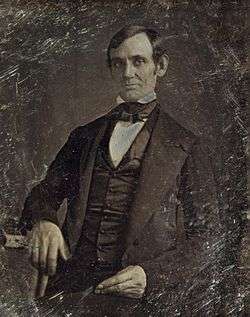
From the early 1830s, Lincoln was a steadfast Whig and professed to friends in 1861 to be "an old line Whig, a disciple of Henry Clay".[98] The party, including Lincoln, favored economic modernization in banking, protective tariffs to fund internal improvements including railroads, and espoused urbanization as well.[99]
Lincoln ran for the Whig nomination for Illinois's 7th district of the U.S. House of Representatives in 1843, but was defeated by John J. Hardin. However, Lincoln won support for the principle of rotation, whereby Hardin would retire after only one term to allow for the nomination of another candidate. Lincoln hoped that this arrangement would lead to his nomination in 1846.[100] Lincoln was indeed elected to the House of Representatives in 1846, where he served one two-year term. He was the only Whig in the Illinois delegation, but he showed his party loyalty by participating in almost all votes and making speeches that echoed the party line.[101] Lincoln, in collaboration with abolitionist Congressman Joshua R. Giddings, wrote a bill to abolish slavery in the District of Columbia with compensation for the owners, enforcement to capture fugitive slaves, and a popular vote on the matter. He abandoned the bill when it failed to garner sufficient Whig supporters.[102]
On foreign and military policy, Lincoln spoke out against the Mexican–American War, which he attributed to President Polk's desire for "military glory—that attractive rainbow, that rises in showers of blood".[103] Lincoln also supported the Wilmot Proviso, which, if it had been adopted, would have banned slavery in any U.S. territory won from Mexico.[104] [105]
Lincoln emphasized his opposition to Polk by drafting and introducing his Spot Resolutions. The war had begun with a Mexican slaughter of American soldiers in territory disputed by Mexico and the U.S. Polk insisted that Mexican soldiers had "invaded our territory and shed the blood of our fellow-citizens on our own soil".[106][107] Lincoln demanded that Polk show Congress the exact spot on which blood had been shed and prove that the spot was on American soil.[107][108]
Congress never enacted the resolution or even debated it, the national papers ignored it, and it resulted in a loss of political support for Lincoln in his district. One Illinois newspaper derisively nicknamed him "spotty Lincoln".[109][110][111] Lincoln later regretted some of his statements, especially his attack on the presidential war-making powers.[112]
Realizing Clay was unlikely to win the presidency, Lincoln, who had pledged in 1846 to serve only one term in the House, supported General Zachary Taylor for the Whig nomination in the 1848 presidential election.[113] Taylor won and Lincoln hoped to be appointed Commissioner of the General Land Office, but that lucrative patronage job went to an Illinois rival, Justin Butterfield, considered by the administration to be a highly skilled lawyer, but in Lincoln's view, an "old fossil".[114] The administration offered him the consolation prize of secretary or governor of the Oregon Territory.[115] This distant territory was a Democratic stronghold, and acceptance of the post would have effectively ended his legal and political career in Illinois, so he declined and resumed his law practice.[116]
Prairie lawyer
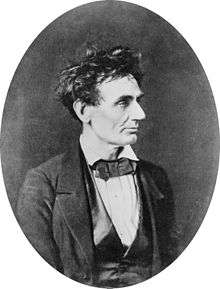
Lincoln returned to practicing law in Springfield, handling "every kind of business that could come before a prairie lawyer".[117] Twice a year for 16 years, 10 weeks at a time, he appeared in county seats in the midstate region when the county courts were in session.[118] Lincoln handled many transportation cases in the midst of the nation's western expansion, particularly the conflicts arising from the operation of river barges under the many new railroad bridges. As a riverboat man, Lincoln initially favored those interests, but ultimately represented whoever hired him.[119] In fact, he later represented a bridge company against a riverboat company in a landmark case involving a canal boat that sank after hitting a bridge.[120][121] In 1849, he received a patent for a flotation device for the movement of boats in shallow water. The idea was never commercialized, but Lincoln is the only president to hold a patent.[122][123]
In 1851, he represented the Alton & Sangamon Railroad in a dispute with one of its shareholders, James A. Barret, who had refused to pay the balance on his pledge to buy shares in the railroad on the grounds that the company had changed its original train route.[124][125] Lincoln successfully argued that the railroad company was not bound by its original charter extant at the time of Barret's pledge; the charter was amended in the public interest to provide a newer, superior, and less expensive route, and the corporation retained the right to demand Barret's payment. The decision by the Illinois Supreme Court has been cited by numerous other courts in the nation.[124] Lincoln appeared before the Illinois Supreme Court in 175 cases, in 51 as sole counsel, of which 31 were decided in his favor.[126] From 1853 to 1860, another of Lincoln's largest clients was the Illinois Central Railroad.[127] Lincoln's reputation with clients gave rise to his nickname "Honest Abe."[128]
Lincoln's most notable criminal trial occurred in 1858 when he defended William "Duff" Armstrong, who was on trial for the murder of James Preston Metzker.[129] The case is famous for Lincoln's use of a fact established by judicial notice in order to challenge the credibility of an eyewitness. After an opposing witness testified seeing the crime in the moonlight, Lincoln produced a Farmers' Almanac showing the moon was at a low angle, drastically reducing visibility. Based on this evidence, Armstrong was acquitted.[129]
Lincoln rarely raised objections in the courtroom; but in an 1859 case, where he defended a cousin, Peachy Harrison, who was accused of stabbing another to death, Lincoln angrily protested the judge's decision to exclude evidence favorable to his client. Instead of holding Lincoln in contempt of court as was expected, the judge, a Democrat, reversed his ruling, allowing the evidence and acquitting Harrison.[129][130]
Republican politics 1854–60
Emergence as Republican leader
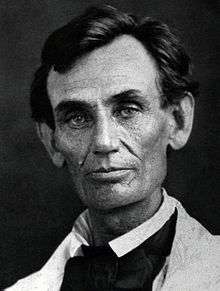
The debate over the status of slavery in the territories exacerbated sectional tensions between the slave-holding South and the North, and the Compromise of 1850 failed to defuse the issue.[131] In the early 1850s, Lincoln supported efforts for sectional mediation, and his 1852 eulogy for Henry Clay focused on the latter's support for gradual emancipation and opposition to "both extremes" on the slavery issue.[132] As the 1850s progressed, the debate over slavery in the Nebraska Territory and Kansas Territory became particularly acrimonious, and Senator Stephen A. Douglas of Illinois proposed popular sovereignty as a compromise measure; the proposal would take the issue of slavery out of the hands of Congress by allowing the electorate of each territory to decide the status of slavery themselves. The proposal alarmed many Northerners, who hoped to stop the spread of slavery into the territories. Despite this Northern opposition, Douglas's Kansas–Nebraska Act narrowly passed Congress in May 1854.[133]
For months after its passage, Lincoln did not publicly comment on the Kansas–Nebraska Act, but he came to strongly oppose it.[134] On October 16, 1854, in his "Peoria Speech", Lincoln declared his opposition to slavery, which he repeated en route to the presidency.[135] Speaking in his Kentucky accent, with a very powerful voice,[136] he said the Kansas Act had a "declared indifference, but as I must think, a covert real zeal for the spread of slavery. I cannot but hate it. I hate it because of the monstrous injustice of slavery itself. I hate it because it deprives our republican example of its just influence in the world ..."[137] Lincoln's attacks on the Kansas–Nebraska Act marked his return to political life.[138]
Nationally, the Whigs were irreparably split by the Kansas–Nebraska Act and other efforts to compromise on the slavery issue. Reflecting the demise of his party, Lincoln would write in 1855, "I think I am a Whig, but others say there are no Whigs, and that I am an abolitionist [...] I do no more than oppose the extension of slavery."[139] Drawing on the antislavery portion of the Whig Party, and combining Free Soil, Liberty, and antislavery Democratic Party members, the new Republican Party formed as a northern party dedicated to antislavery.[140] Lincoln resisted early attempts to recruit him to the new party, fearing that it would serve as a platform for extreme abolitionists.[141] Lincoln also still hoped to rejuvenate the ailing Whig Party, though he bemoaned his party's growing closeness with the nativist Know Nothing movement.[142]
In the 1854 elections, Lincoln was elected to the Illinois legislature but declined to take his seat.[138] In the aftermath of the elections, which showed the power and popularity of the movement opposed to the Kansas–Nebraska Act, Lincoln instead sought election to the United States Senate.[143] At that time, senators were elected by the state legislature.[144] After leading in the first six rounds of voting, but unable to obtain a majority, Lincoln instructed his backers to vote for Lyman Trumbull. Trumbull was an antislavery Democrat, and had received few votes in the earlier ballots; his supporters, also antislavery Democrats, had vowed not to support any Whig. Lincoln's decision to withdraw enabled his Whig supporters and Trumbull's antislavery Democrats to combine and defeat the mainstream Democratic candidate, Joel Aldrich Matteson.[145]
In part due to the ongoing violent political confrontations in the Kansas, opposition to the Kansas–Nebraska Act remained strong in Illinois and throughout the North. As the 1856 elections approached, Lincoln abandoned the defunct Whig Party in favor of the Republicans. He attended the May 1856 Bloomington Convention, which formally established the Illinois Republican Party. The convention platform asserted that Congress had the right to regulate slavery in the territories and called for the immediate admission of Kansas as a free state. Lincoln gave the final speech of the convention, in which he endorsed the party platform and called for the preservation of the Union.[146] At the June 1856 Republican National Convention, Lincoln received significant support on the vice presidential ballot, though the party nominated a ticket of John C. Frémont and William Dayton. Lincoln strongly supported the Republican ticket, campaigning for the party throughout Illinois. The Democrats nominated former Ambassador James Buchanan, who had been out of the country since 1853 and thus had avoided the debate over slavery in the territories, while the Know Nothings nominated former Whig President Millard Fillmore.[147] In the 1856 elections, Buchanan defeated both his challengers, but Frémont won several Northern states and Republican William Henry Bissell won election as Governor of Illinois. Though Lincoln did not himself win office, his vigorous campaigning had made him the leading Republican in Illinois.[148]
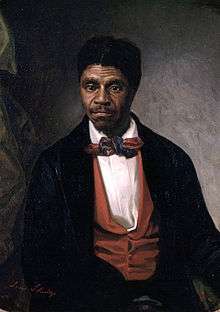
Eric Foner (2010) contrasts the abolitionists and anti-slavery Radical Republicans of the Northeast who saw slavery as a sin, with the conservative Republicans who thought it was bad because it hurt white people and blocked progress. Foner argues that Lincoln was a moderate in the middle, opposing slavery primarily because it violated the republicanism principles of the Founding Fathers, especially the equality of all men and democratic self-government as expressed in the Declaration of Independence.[149]
In March 1857, the Supreme Court issued its decision in Dred Scott v. Sandford. The opinion by Chief Justice Roger B. Taney held that blacks were not citizens and derived no rights from the Constitution. While many Democrats hoped that Dred Scott would end the dispute over slavery in the territories, the decision sparked further outrage in the North.[150] Lincoln denounced the decision, alleging it was the product of a conspiracy of Democrats to support the Slave Power.[151] Lincoln argued, "The authors of the Declaration of Independence never intended 'to say all were equal in color, size, intellect, moral developments, or social capacity', but they 'did consider all men created equal—equal in certain inalienable rights, among which are life, liberty, and the pursuit of happiness'."[152]
Lincoln–Douglas debates and Cooper Union speech
Douglas was up for re-election in 1858, and Lincoln hoped to defeat the powerful Illinois Democrat. With the former Democrat Trumbull now serving as a Republican Senator, many in the party felt that a former Whig should be nominated in 1858, and Lincoln's 1856 campaigning and willingness to support Trumbull in 1854 had earned him favor in the party.[153] Some eastern Republicans favored the reelection of Douglas for the Senate in 1858, since he had led the opposition to the Lecompton Constitution, which would have admitted Kansas as a slave state.[154] But many Illinois Republicans resented this eastern interference. For the first time, Illinois Republicans held a convention to agree upon a Senate candidate, and Lincoln won the party's Senate nomination with little opposition.[155]
Accepting the nomination, Lincoln delivered his House Divided Speech, drawing on Mark 3:25, "A house divided against itself cannot stand. I believe this government cannot endure permanently half slave and half free. I do not expect the Union to be dissolved—I do not expect the house to fall—but I do expect it will cease to be divided. It will become all one thing, or all the other."[156] The speech created an evocative image of the danger of disunion caused by the slavery debate, and rallied Republicans across the North.[157] The stage was then set for the campaign for statewide election of the Illinois legislature which would, in turn, select Lincoln or Douglas as its U.S. senator.[158] On being informed of Lincoln's nomination, Douglas stated "[Lincoln] is the strong man of the party...and if I beat him, my victory will be hardly won."[159]
The Senate campaign featured the seven Lincoln–Douglas debates of 1858, the most famous political debates in American history.[160] The principals stood in stark contrast both physically and politically. Lincoln warned that "The Slave Power" was threatening the values of republicanism, and accused Douglas of distorting the values of the Founding Fathers that all men are created equal, while Douglas emphasized his Freeport Doctrine, that local settlers were free to choose whether to allow slavery or not, and accused Lincoln of having joined the abolitionists.[161] The debates had an atmosphere of a prize fight and drew crowds in the thousands. Lincoln stated Douglas' popular sovereignty theory was a threat to the nation's morality and that Douglas represented a conspiracy to extend slavery to free states. Douglas said that Lincoln was defying the authority of the U.S. Supreme Court and the Dred Scott decision.[162]
Though the Republican legislative candidates won more popular votes, the Democrats won more seats, and the legislature re-elected Douglas to the Senate. Despite the bitterness of the defeat for Lincoln, his articulation of the issues gave him a national political reputation.[163] In May 1859, Lincoln purchased the Illinois Staats-Anzeiger, a German-language newspaper which was consistently supportive; most of the state's 130,000 German Americans voted Democratic but there was Republican support that a German-language paper could mobilize.[164] In the aftermath of the 1858 election, newspapers frequently mentioned Lincoln as a potential Republican presidential candidate in 1860, with William H. Seward, Salmon P. Chase, Edward Bates, and Simon Cameron looming as rivals for the nomination. While Lincoln was popular in the Midwest, he lacked support in the Northeast, and was unsure as to whether he should seek the presidency.[165] In January 1860, Lincoln told a group of political allies that he would accept the 1860 presidential nomination if offered, and in the following months several local papers endorsed Lincoln for president.[166]
On February 27, 1860, New York party leaders invited Lincoln to give a speech at Cooper Union to a group of powerful Republicans. Lincoln argued that the Founding Fathers had little use for popular sovereignty and had repeatedly sought to restrict slavery. Lincoln insisted the moral foundation of the Republicans required opposition to slavery, and rejected any "groping for some middle ground between the right and the wrong".[167] Despite his inelegant appearance—many in the audience thought him awkward and even ugly[168]—Lincoln demonstrated an intellectual leadership that brought him into the front ranks of the party and into contention for the Republican presidential nomination. Journalist Noah Brooks reported, "No man ever before made such an impression on his first appeal to a New York audience."[169][170]
Historian Donald described the speech as a "superb political move for an unannounced candidate, to appear in one rival's (Seward) own state at an event sponsored by the second rival's (Chase) loyalists, while not mentioning either by name during its delivery".[171] In response to an inquiry about his presidential intentions, Lincoln said, "The taste is in my mouth a little."[172]
1860 Presidential nomination and campaign
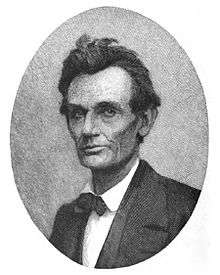
On May 9–10, 1860, the Illinois Republican State Convention was held in Decatur.[173] Lincoln's followers organized a campaign team led by David Davis, Norman Judd, Leonard Swett, and Jesse DuBois, and Lincoln received his first endorsement to run for the presidency.[174] Exploiting the embellished legend of his frontier days with his father (clearing the land and splitting fence rails with an ax), Lincoln's supporters adopted the label of "The Rail Candidate".[175] In 1860 Lincoln described himself: "I am in height, six feet, four inches, nearly; lean in flesh, weighing, on an average, one hundred and eighty pounds; dark complexion, with coarse black hair, and gray eyes."[176]
On May 18, at the Republican National Convention in Chicago, Lincoln became the Republican candidate on the third ballot, beating candidates such as Seward and Chase. A former Democrat, Hannibal Hamlin of Maine, was nominated for Vice President to balance the ticket. Lincoln's success depended on his campaign team, his reputation as a moderate on the slavery issue, and his strong support for Whiggish programs of internal improvements and the protective tariff.[177]
On the third ballot Pennsylvania put him over the top. Pennsylvania iron interests were reassured by his support for protective tariffs.[178] Lincoln's managers had been adroitly focused on this delegation as well as the others, while following Lincoln's strong dictate to "Make no contracts that bind me".[179]
Most Republicans agreed with Lincoln that the North was the aggrieved party, as the Slave Power tightened its grasp on the national government with the Dred Scott decision and the presidency of James Buchanan. Throughout the 1850s, Lincoln doubted the prospects of civil war, and his supporters rejected claims that his election would incite secession.[180] Meanwhile, Douglas was selected as the candidate of the Northern Democrats. Delegates from 11 slave states walked out of the Democratic convention, disagreeing with Douglas' position on popular sovereignty, and ultimately selected incumbent Vice President John C. Breckinridge as their candidate.[181] A group of former Whigs and Know Nothings formed the Constitutional Union Party and nominated John Bell of Tennessee. Lincoln and Douglas would compete for votes in the North, while Bell and Breckinridge primarily found support in the South.[153]
Lincoln had a highly effective campaign team who carefully projected his image as an ideal candidate. As Michael Martinez says:
Lincoln and his political advisers manipulated his image and background....Sometimes he appeared as a straight-shooting, plain-talking, common-sense-wielding man of the people. His image as the "Rail Splitter" dates from this era. His supporters also portrayed him as "Honest Abe," the country fellow who was simply dressed and not especially polished or formal in his manner but who was as honest and trustworthy as his legs were long. Even Lincoln's tall, gangly frame was used to good advantage during the campaign as many drawings and posters show the candidates sprinting past his vertically challenged rivals. At other times, Lincoln appeared as a sophisticated, thoughtful, articulate, "presidential" candidate.[182]
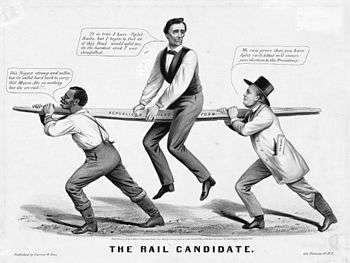
Prior to the Republican convention, the Lincoln campaign began cultivating a nationwide youth organization, the Wide Awakes, which it used to generate popular support for Lincoln throughout the country to spearhead large voter registration drives, knowing that new voters and young voters tend to embrace new and young parties.[183] As Lincoln's ideas of abolishing slavery grew, so did his supporters. People of the Northern states knew the Southern states would vote against Lincoln because of his ideas of anti-slavery and took action to rally supporters for Lincoln.[184]
As Douglas and the other candidates went through with their campaigns, Lincoln was the only one of them who gave no speeches. Instead, he monitored the campaign closely and relied on the enthusiasm of the Republican Party. The party did the leg work that produced majorities across the North, and produced an abundance of campaign posters, leaflets, and newspaper editorials. There were thousands of Republican speakers who focused first on the party platform, and second on Lincoln's life story, emphasizing his childhood poverty. The goal was to demonstrate the superior power of "free labor", whereby a common farm boy could work his way to the top by his own efforts.[185] The Republican Party's production of campaign literature dwarfed the combined opposition; a Chicago Tribune writer produced a pamphlet that detailed Lincoln's life, and sold 100,000 to 200,000 copies.[186]
Presidency
1860 election and secession
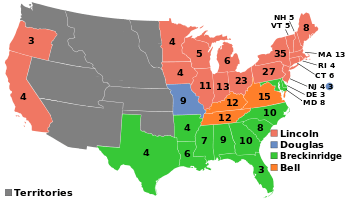
On November 6, 1860, Lincoln was elected the 16th president of the United States, beating Douglas, Breckinridge, and Bell. He was the first president from the Republican Party. His victory was entirely due to the strength of his support in the North and West; no ballots were cast for him in 10 of the 15 Southern slave states, and he won only two of 996 counties in all the Southern states.[187]
Lincoln received 1,866,452 votes, Douglas 1,376,957 votes, Breckinridge 849,781 votes, and Bell 588,789 votes. Turnout was 82.2 percent, with Lincoln winning the free Northern states, as well as California and Oregon. Douglas won Missouri, and split New Jersey with Lincoln.[188] Bell won Virginia, Tennessee, and Kentucky, and Breckinridge won the rest of the South.[189]
Although Lincoln won only a plurality of the popular vote, his victory in the electoral college was decisive: Lincoln had 180 and his opponents added together had only 123. There were fusion tickets in which all of Lincoln's opponents combined to support the same slate of Electors in New York, New Jersey, and Rhode Island, but even if the anti-Lincoln vote had been combined in every state, Lincoln still would have won a majority in the Electoral College.[190]

As Lincoln's election became evident, secessionists made clear their intent to leave the Union before he took office the next March.[191] On December 20, 1860, South Carolina took the lead by adopting an ordinance of secession; by February 1, 1861, Florida, Mississippi, Alabama, Georgia, Louisiana, and Texas followed.[192][193] Six of these states then adopted a constitution and declared themselves to be a sovereign nation, the Confederate States of America.[192] The upper South and border states (Delaware, Maryland, Virginia, North Carolina, Tennessee, Kentucky, Missouri, and Arkansas) listened to, but initially rejected, the secessionist appeal.[194] President Buchanan and President-elect Lincoln refused to recognize the Confederacy, declaring secession illegal.[195] The Confederacy selected Jefferson Davis as its provisional President on February 9, 1861.[196]
There were attempts at compromise. The Crittenden Compromise would have extended the Missouri Compromise line of 1820, dividing the territories into slave and free, contrary to the Republican Party's free-soil platform.[197] Lincoln rejected the idea, saying, "I will suffer death before I consent ... to any concession or compromise which looks like buying the privilege to take possession of this government to which we have a constitutional right."[198]
Lincoln, however, did tacitly support the proposed Corwin Amendment to the Constitution, which passed Congress before Lincoln came into office and was then awaiting ratification by the states. That proposed amendment would have protected slavery in states where it already existed and would have guaranteed that Congress would not interfere with slavery without Southern consent.[199][200] A few weeks before the war, Lincoln sent a letter to every governor informing them Congress had passed a joint resolution to amend the Constitution.[201] Lincoln was open to the possibility of a constitutional convention to make further amendments to the Constitution.[202]
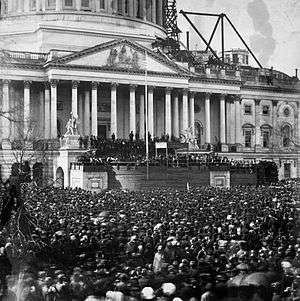
En route to his inauguration by train, Lincoln addressed crowds and legislatures across the North.[203] The president-elect then evaded possible assassins in Baltimore, who were uncovered by Lincoln's head of security, Allan Pinkerton. On February 23, 1861, he arrived in disguise in Washington, D.C., which was placed under substantial military guard.[204] Lincoln directed his inaugural address to the South, proclaiming once again that he had no intention, or inclination, to abolish slavery in the Southern states:
Apprehension seems to exist among the people of the Southern States that by the accession of a Republican Administration their property and their peace and personal security are to be endangered. There has never been any reasonable cause for such apprehension. Indeed, the most ample evidence to the contrary has all the while existed and been open to their inspection. It is found in nearly all the published speeches of him who now addresses you. I do but quote from one of those speeches when I declare that "I have no purpose, directly or indirectly, to interfere with the institution of slavery in the States where it exists. I believe I have no lawful right to do so, and I have no inclination to do so."
The President ended his address with an appeal to the people of the South: "We are not enemies, but friends. We must not be enemies ... The mystic chords of memory, stretching from every battlefield, and patriot grave, to every living heart and hearthstone, all over this broad land, will yet swell the chorus of the Union, when again touched, as surely they will be, by the better angels of our nature."[206] The failure of the Peace Conference of 1861 signaled that legislative compromise was impossible. By March 1861, no leaders of the insurrection had proposed rejoining the Union on any terms. Meanwhile, Lincoln and the Republican leadership agreed that the dismantling of the Union could not be tolerated.[207] Lincoln said as the war was ending:[208]
Both parties deprecated war, but one of them would make war rather than let the Nation survive, and the other would accept war rather than let it perish, and the war came.
The Civil War
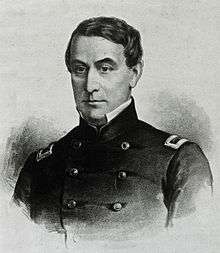
The commander of Fort Sumter, South Carolina, Major Robert Anderson, sent a request for provisions to Washington, and the execution of Lincoln's order to meet that request was seen by the secessionists as an act of war. On April 12, 1861, Confederate forces fired on Union troops at Fort Sumter, forcing them to surrender, beginning the war. Historian Allan Nevins argued that the newly inaugurated Lincoln made three miscalculations: underestimating the gravity of the crisis, exaggerating the strength of Unionist sentiment in the South, and not realizing the Southern Unionists were insisting there be no invasion.[209]
William Tecumseh Sherman talked to Lincoln during inauguration week and was "sadly disappointed" at his failure to realize that "the country was sleeping on a volcano" and that the South was preparing for war.[210] Historian David Herbert Donald concludes that, "His repeated efforts to avoid collision in the months between inauguration and the firing on Ft. Sumter showed he adhered to his vow not to be the first to shed fraternal blood. But he also vowed not to surrender the forts. The only resolution of these contradictory positions was for the confederates to fire the first shot; they did just that."[211]
On April 15, Lincoln called on all the states to send detachments totaling 75,000 troops to recapture forts, protect Washington, and "preserve the Union", which, in his view, still existed intact despite the actions of the seceding states. This call forced the states to choose sides. Virginia declared its secession and was rewarded with the Confederate capital, despite the exposed position of Richmond so close to Union lines. North Carolina, Tennessee, and Arkansas also voted for secession over the next two months. Secession sentiment was strong in Missouri and Maryland, but did not prevail; Kentucky tried to be neutral.[212] The Confederate attack on Fort Sumter rallied Americans north of the Mason-Dixon line to the defense of the American nation. Historian Allan Nevins says:[213][214]
The thunderclap of Sumter produced a startling crystallization of Northern sentiment ... Anger swept the land. From every side came news of mass meetings, speeches, resolutions, tenders of business support, the muster of companies and regiments, the determined action of governors and legislatures.
States sent Union regiments south in response to Lincoln's call to save the capital and confront the rebellion. On April 19, mobs in Baltimore, which controlled the rail links, attacked Union troops who were changing trains, and local leaders' groups later burned critical rail bridges to the capital. The Army responded by arresting local Maryland officials. Lincoln suspended the writ of habeas corpus in areas the army felt it needed to secure for troops to reach Washington.[215] John Merryman, a Maryland official involved in hindering the U.S. troop movements, petitioned Supreme Court Chief Justice and Marylander, Roger B. Taney, author of the controversial pro-slavery Dred Scott opinion, to issue a writ of habeas corpus, and in June Taney, acting as a circuit judge and not speaking for the Supreme Court, issued the writ, because in his opinion only Congress could suspend the writ. Lincoln continued the army policy that the writ was suspended in limited areas despite the Ex parte Merryman ruling.[216][217]
Greenbacks currency
Before the Civil War, the only money issued by the United States was gold and silver coins, and only such coins ("specie") were legal tender; that is, payment in that form had to be accepted. Paper currency in the form of banknotes was issued by privately owned banks.
Greenbacks were paper currency (printed in green on the back) issued by the United States during the American Civil War, they were in two forms:
Demand Notes, issued In July 1861, Congress authorized $50,000,000 in Demand Notes. They bore no interest, but could be redeemed for specie "on demand". They were not legal tender (before March 1862), but like Treasury Notes could be used to pay customs duties. Unlike private and state banknotes, Demand Notes were printed on both sides. The reverse side was printed in green ink, and so the Demand Notes were dubbed "greenbacks". Initially they were discounted relative to gold, but being fully redeemable in gold were soon at par. In December 1861, the government had to suspend redemption, and they declined. Chase authorized paying interest on Demand Notes, which sustained their value. Importers therefore continued to use Demand Notes in place of gold. In March 1862, Demand Notes were made legal tender. As Demand Notes were used to pay duties, they were taken out of circulation. By mid-1863, about 95% of them were gone.
The other form of greenbacks where the United States Notes issued in 1862–1865. They were legal tender by law, but were not backed by gold or silver, only the credibility of the U.S. government.[218] Could not be used to pay customs duties or interest on the public debt.
Union military strategy
After the Battle of Fort Sumter, Lincoln realized the importance of taking immediate executive control of the war and forming an overall Union military strategy to put down the rebellion. Lincoln encountered an unprecedented political and military crisis, and he responded as commander-in-chief, using unprecedented powers. He expanded his war powers, and imposed a blockade on all the Confederate shipping ports, disbursed funds before appropriation by Congress, and after suspending habeas corpus, arrested and imprisoned thousands of suspected Confederate sympathizers. Lincoln was supported by Congress and the northern public for these actions. In addition, Lincoln had to contend with reinforcing strong Union sympathies in the border slave states and keeping the war from becoming an international conflict.[219]
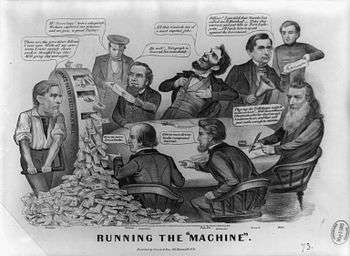
The war effort was the source of continued disparagement of Lincoln, and dominated his time and attention. From the start, it was clear that bipartisan support would be essential to success in the war effort, and any manner of compromise alienated factions on both sides of the aisle, such as the appointment of Republicans and Democrats to command positions in the Union Army. Copperheads criticized Lincoln for refusing to compromise on the slavery issue. Conversely, the Radical Republicans criticized him for moving too slowly in abolishing slavery.[220] On August 6, 1861, Lincoln signed the Confiscation Act that authorized judiciary proceedings to confiscate and free slaves who were used to support the Confederate war effort. In practice, the law had little effect, but it did signal political support for abolishing slavery in the Confederacy.[221]
In late August 1861, General John C. Frémont, the 1856 Republican presidential nominee, issued, without consulting his superiors in Washington, a proclamation of martial law in Missouri. He declared that any citizen found bearing arms could be court-martialed and shot, and that slaves of persons aiding the rebellion would be freed. Frémont was already under a cloud with charges of negligence in his command of the Department of the West compounded with allegations of fraud and corruption. Lincoln overruled Frémont's proclamation. Lincoln believed that Fremont's emancipation was political, neither militarily necessary nor legal.[222] After Lincoln acted, Union enlistments from Maryland, Kentucky, and Missouri increased by over 40,000 troops.[223]
In foreign policy, Lincoln's main goal was to stop military aid from countries abroad to the Confederacy.[224] Lincoln left most diplomatic matters to his Secretary of State, William Seward.[224] At times Seward was too bellicose, so for balance Lincoln maintained a close working relationship with Senator Charles Sumner, the chairman of the Senate Foreign Relations Committee.[225] The Trent Affair of late 1861 threatened war with Great Britain. The U.S. Navy had illegally intercepted a British mail ship, the Trent, on the high seas and seized two Confederate envoys; Britain protested vehemently while the U.S. cheered. Lincoln ended the crisis by releasing the two diplomats. Biographer James G. Randall has dissected Lincoln's successful techniques:[226]
his restraint, his avoidance of any outward expression of truculence, his early softening of State Department's attitude toward Britain, his deference toward Seward and Sumner, his withholding of his own paper prepared for the occasion, his readiness to arbitrate, his golden silence in addressing Congress, his shrewdness in recognizing that war must be averted, and his clear perception that a point could be clinched for America's true position at the same time that full satisfaction was given to a friendly country.
Lincoln painstakingly monitored the telegraphic reports coming into the War Department headquarters. He kept close tabs on all phases of the military effort, consulted with governors, and selected generals based on their past success (as well as their state and party). In January 1862, after many complaints of inefficiency and profiteering in the War Department, Lincoln replaced Simon Cameron with Edwin Stanton as War Secretary. Stanton centralized the War Department's activities, auditing and cancelling contracts, saving the federal government $17,000,000.[227] Stanton was a staunchly Unionist pro-business conservative Democrat who moved toward the Radical Republican faction. Nevertheless, he worked more often and more closely with Lincoln than any other senior official. "Stanton and Lincoln virtually conducted the war together," say Thomas and Hyman.[228]
In terms of war strategy, Lincoln articulated two priorities: to ensure that Washington was well-defended, and to conduct an aggressive war effort that would satisfy the demand in the North for prompt, decisive victory; major Northern newspaper editors expected victory within 90 days.[229] Twice a week, Lincoln would meet with his cabinet in the afternoon, and occasionally Mary Lincoln would force him to take a carriage ride because she was concerned he was working too hard.[230] Lincoln learned from reading the theoretical book of his chief of staff General Henry Halleck, a disciple of the European strategist Jomini; he began to appreciate the critical need to control strategic points, such as the Mississippi River.[231] Lincoln saw the importance of Vicksburg and understood the necessity of defeating the enemy's army, rather than simply capturing territory.[232]
General McClellan
After the Union rout at Bull Run, the first major battle of the Civil War, and the retirement of the aged Winfield Scott in late 1861, Lincoln appointed Major General George B. McClellan general-in-chief of all the Union armies.[233][234] McClellan, a young West Point graduate, railroad executive, and Pennsylvania Democrat, took several months to plan and attempt his Peninsula Campaign, longer than Lincoln wanted. The campaign's objective was to capture Richmond by moving the Army of the Potomac by boat to the peninsula and then overland to the Confederate capital. McClellan's repeated delays frustrated Lincoln and Congress, as did his position that no troops were needed to defend Washington. Lincoln insisted on holding some of McClellan's troops in defense of the capital; McClellan, who consistently overestimated the strength of Confederate troops, blamed this decision for the ultimate failure of the Peninsula Campaign.[235]
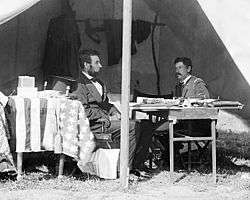
Lincoln removed McClellan as general-in-chief in March 1862, after McClellan's "Harrison's Landing Letter", in which he offered unsolicited political advice to Lincoln urging caution in the war effort.[236] The office remained empty until July, when Henry Halleck was selected for it.[237] McClellan's letter incensed Radical Republicans, who successfully pressured Lincoln to appoint John Pope, a Republican, as head of the new Army of Virginia. Pope complied with Lincoln's strategic desire to move toward Richmond from the north, thus protecting the capital from attack.[238]
However, lacking requested reinforcements from McClellan, now commanding the Army of the Potomac, Pope was soundly defeated at the Second Battle of Bull Run in the summer of 1862, forcing the Army of the Potomac to defend Washington for a second time.[238] The war also expanded with naval operations in 1862 when the CSS Virginia, formerly the USS Merrimack, damaged or destroyed three Union vessels in Norfolk, Virginia, before being engaged and damaged by the USS Monitor. Lincoln closely reviewed the dispatches and interrogated naval officers during their clash in the Battle of Hampton Roads.[239]
Despite his dissatisfaction with McClellan's failure to reinforce Pope, Lincoln was desperate, and restored him to command of all forces around Washington, to the dismay of all in his cabinet but Seward.[240] Two days after McClellan's return to command, General Robert E. Lee's forces crossed the Potomac River into Maryland, leading to the Battle of Antietam in September 1862.[241] The ensuing Union victory was among the bloodiest in American history, but it enabled Lincoln to announce that he would issue an Emancipation Proclamation in January. Having composed the Proclamation some time earlier, Lincoln had waited for a military victory to publish it to avoid it being perceived as the product of desperation.[242]
McClellan then resisted the President's demand that he pursue Lee's retreating and exposed army, while his counterpart General Don Carlos Buell likewise refused orders to move the Army of the Ohio against rebel forces in eastern Tennessee. As a result, Lincoln replaced Buell with William Rosecrans; and, after the 1862 midterm elections, he replaced McClellan with Republican Ambrose Burnside. Both of these replacements were political moderates and prospectively more supportive of the Commander-in-Chief.[243]
.jpg)
Burnside, against the advice of the president, prematurely launched an offensive across the Rappahannock River and was stunningly defeated by Lee at Fredericksburg in December. Not only had Burnside been defeated on the battlefield, but his soldiers were disgruntled and undisciplined. Desertions during 1863 were in the thousands and they increased after Fredericksburg.[244] Lincoln brought in Joseph Hooker, despite his record of loose talk about the need for a military dictatorship.[245]
The mid-term elections in 1862 brought the Republicans severe losses due to sharp disfavor with the administration over its failure to deliver a speedy end to the war, as well as rising inflation, new high taxes, rumors of corruption, the suspension of habeas corpus, the military draft law, and fears that freed slaves would undermine the labor market. The Emancipation Proclamation announced in September gained votes for the Republicans in the rural areas of New England and the upper Midwest, but it lost votes in the cities and the lower Midwest.[246]
While Republicans were discouraged, Democrats were energized and did especially well in Pennsylvania, Ohio, Indiana, and New York. The Republicans did maintain their majorities in Congress and in the major states, except New York. The Cincinnati Gazette contended that the voters were "depressed by the interminable nature of this war, as so far conducted, and by the rapid exhaustion of the national resources without progress".[246]
In the spring of 1863, Lincoln was optimistic about upcoming military campaigns to the point of thinking the end of the war could be near if a string of victories could be put together; these plans included attacks by Hooker on Lee north of Richmond, Rosecrans on Chattanooga, Grant on Vicksburg, and a naval assault on Charleston.[247]
Hooker was routed by Lee at the Battle of Chancellorsville in May,[248] but continued to command his troops for some weeks. He ignored Lincoln's order to divide his troops, and possibly force Lee to do the same in Harper's Ferry, and tendered his resignation, which Lincoln accepted. He was replaced by George Meade, who followed Lee into Pennsylvania for the Gettysburg Campaign, which was a victory for the Union, though Lee's army avoided capture. At the same time, after initial setbacks, Grant laid siege to Vicksburg and the Union navy attained some success in Charleston harbor.[249] After the Battle of Gettysburg, Lincoln clearly understood that his military decisions would be more effectively carried out by conveying his orders through his War Secretary or his general-in-chief on to his generals, who resented his civilian interference with their own plans. Even so, he often continued to give detailed directions to his generals as Commander-in-Chief.[250]
Emancipation Proclamation
Lincoln understood that the Federal government's power to end slavery was limited by the Constitution, which before 1865, committed the issue to individual states. He argued before and during his election that the eventual extinction of slavery would result from preventing its expansion into new U.S. territory. At the beginning of the war, he also sought to persuade the states to accept compensated emancipation in return for their prohibition of slavery. Lincoln believed that curtailing slavery in these ways would economically expunge it, as envisioned by the Founding Fathers, under the constitution.[251] President Lincoln rejected two geographically limited emancipation attempts by Major General John C. Frémont in August 1861 and by Major General David Hunter in May 1862, on the grounds that it was not within their power, and it would upset the border states loyal to the Union.[252]
On June 19, 1862, endorsed by Lincoln, Congress passed an act banning slavery on all federal territory. In July, the Confiscation Act of 1862 was passed, which set up court procedures that could free the slaves of anyone convicted of aiding the rebellion. Although Lincoln believed it was not within Congress's power to free the slaves within the states, he approved the bill in deference to the legislature. He felt such action could only be taken by the Commander-in-Chief using war powers granted to the president by the Constitution, and Lincoln was planning to take that action. In that month, Lincoln discussed a draft of the Emancipation Proclamation with his cabinet. In it, he stated that "as a fit and necessary military measure, on January 1, 1863, all persons held as slaves in the Confederate states will thenceforward, and forever, be free".[253]
Privately, Lincoln concluded at this point that the slave base of the Confederacy had to be eliminated. However, Copperheads argued that emancipation was a stumbling block to peace and reunification. Republican editor Horace Greeley of the highly influential New York Tribune fell for the ploy,[254] and Lincoln refuted it directly in a shrewd letter of August 22, 1862. Although he said he personally wished all men could be free, Lincoln stated that the primary goal of his actions as the U.S. president (he used the first person pronoun and explicitly refers to his "official duty") was that of preserving the Union:[255]
My paramount object in this struggle is to save the Union, and is not either to save or to destroy slavery. If I could save the Union without freeing any slave I would do it, and if I could save it by freeing all the slaves I would do it; and if I could save it by freeing some and leaving others alone I would also do that. What I do about slavery, and the colored race, I do because I believe it helps to save the Union; and what I forbear, I forbear because I do not believe it would help to save the Union ... [¶] I have here stated my purpose according to my view of official duty; and I intend no modification of my oft-expressed personal wish that all men everywhere could be free.[256]
The Emancipation Proclamation, issued on September 22, 1862, and put into effect on January 1, 1863, declared free the slaves in 10 states not then under Union control, with exemptions specified for areas already under Union control in two states.[257] Lincoln spent the next 100 days preparing the army and the nation for emancipation, while Democrats rallied their voters in the 1862 off-year elections by warning of the threat freed slaves posed to northern whites.[258]
Once the abolition of slavery in the rebel states became a military objective, as Union armies advanced south, more slaves were liberated until all three million of them in Confederate territory were freed. Lincoln's comment on the signing of the Proclamation was: "I never, in my life, felt more certain that I was doing right, than I do in signing this paper."[259] For some time, Lincoln continued earlier plans to set up colonies for the newly freed slaves. He commented favorably on colonization in the Emancipation Proclamation, but all attempts at such a massive undertaking failed.[260] A few days after Emancipation was announced, 13 Republican governors met at the War Governors' Conference; they supported the president's Proclamation, but suggested the removal of General George B. McClellan as commander of the Union Army.[261]
Enlisting former slaves in the military was official government policy after the issuance of the Emancipation Proclamation. By the spring of 1863, Lincoln was ready to recruit black troops in more than token numbers. In a letter to Andrew Johnson, the military governor of Tennessee, encouraging him to lead the way in raising black troops, Lincoln wrote, "The bare sight of 50,000 armed and drilled black soldiers on the banks of the Mississippi would end the rebellion at once".[262] By the end of 1863, at Lincoln's direction, General Lorenzo Thomas had recruited 20 regiments of blacks from the Mississippi Valley.[263] Frederick Douglass once observed of Lincoln: "In his company, I was never reminded of my humble origin, or of my unpopular color".[264]
Gettysburg Address (1863)
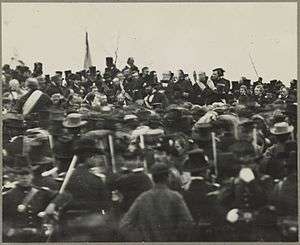
With the great Union victory at the Battle of Gettysburg in July 1863, and the defeat of the Copperheads in the Ohio election in the fall, Lincoln maintained a strong base of party support and was in a strong position to redefine the war effort, despite the New York City draft riots. The stage was set for his address at the Gettysburg battlefield cemetery on November 19, 1863.[265] Defying Lincoln's prediction that "the world will little note, nor long remember what we say here", the Address became the most quoted speech in American history.[266]
In 272 words, and three minutes, Lincoln asserted the nation was born not in 1789, but in 1776, "conceived in Liberty, and dedicated to the proposition that all men are created equal". He defined the war as an effort dedicated to these principles of liberty and equality for all. The emancipation of slaves was now part of the national war effort. He declared that the deaths of so many brave soldiers would not be in vain, that slavery would end as a result of the losses, and the future of democracy in the world would be assured, that "government of the people, by the people, for the people, shall not perish from the earth". Lincoln concluded that the Civil War had a profound objective: a new birth of freedom in the nation.[267][268]
General Grant
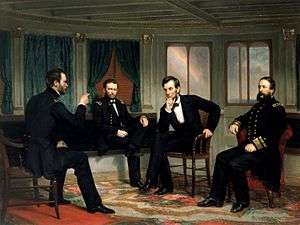
Meade's failure to capture Lee's army as it retreated from Gettysburg, and the continued passivity of the Army of the Potomac, persuaded Lincoln that a change in command was needed. General Ulysses S. Grant's victories at the Battle of Shiloh and in the Vicksburg campaign impressed Lincoln and made Grant a strong candidate to head the Union Army. Responding to criticism of Grant after Shiloh, Lincoln had said, "I can't spare this man. He fights."[269] With Grant in command, Lincoln felt the Union Army could relentlessly pursue a series of coordinated offensives in multiple theaters, and have a top commander who agreed on the use of black troops.[270]
Nevertheless, Lincoln was concerned that Grant might be considering a candidacy for President in 1864, as McClellan was. Lincoln arranged for an intermediary to make inquiry into Grant's political intentions, and being assured that he had none, submitted to the Senate Grant's promotion to commander of the Union Army. He obtained Congress's consent to reinstate for Grant the rank of Lieutenant General, which no officer had held since George Washington.[271]
Grant waged his bloody Overland Campaign in 1864. This is often characterized as a war of attrition, given high Union losses at battles such as the Battle of the Wilderness and Cold Harbor. Even though they had the advantage of fighting on the defensive, the Confederate forces had "almost as high a percentage of casualties as the Union forces".[272] The high casualty figures of the Union alarmed the North; Grant had lost a third of his army, and Lincoln asked what Grant's plans were, to which the general replied, "I propose to fight it out on this line if it takes all summer."[273]
The Confederacy lacked reinforcements, so Lee's army shrank with every costly battle. Grant's army moved south, crossed the James River, forcing a siege and trench warfare outside Petersburg, Virginia. Lincoln then made an extended visit to Grant's headquarters at City Point, Virginia. This allowed the president to confer in person with Grant and William Tecumseh Sherman about the hostilities, as Sherman coincidentally managed a hasty visit to Grant from his position in North Carolina.[274] Lincoln and the Republican Party mobilized support for the draft throughout the North, and replaced the Union losses.[275]
Lincoln authorized Grant to target the Confederate infrastructure—such as plantations, railroads, and bridges—hoping to destroy the South's morale and weaken its economic ability to continue fighting. Grant's move to Petersburg resulted in the obstruction of three railroads between Richmond and the South. This strategy allowed Generals Sherman and Philip Sheridan to destroy plantations and towns in Virginia's Shenandoah Valley. The damage caused by Sherman's March to the Sea through Georgia in 1864 was limited to a 60-mile (97 km) swath, but neither Lincoln nor his commanders saw destruction as the main goal, but rather defeat of the Confederate armies. Mark E. Neely Jr. has argued that there was no effort to engage in "total war" against civilians which he believed did take place during World War II.[276]
Confederate general Jubal Early began a series of assaults in the North that threatened the Capital. During Early's raid on Washington, D.C. in 1864, Lincoln was watching the combat from an exposed position; Captain Oliver Wendell Holmes shouted at him, "Get down, you damn fool, before you get shot!"[277] After repeated calls on Grant to defend Washington, Sheridan was appointed and the threat from Early was dispatched.[278]
As Grant continued to wear down Lee's forces, efforts to discuss peace began. Confederate Vice President Stephens led a group to meet with Lincoln, Seward, and others at Hampton Roads. Lincoln refused to allow any negotiation with the Confederacy as a coequal; his sole objective was an agreement to end the fighting and the meetings produced no results.[279] On April 1, 1865, Grant successfully outflanked Lee's forces in the Battle of Five Forks and nearly encircled Petersburg, and the Confederate government evacuated Richmond. Days later, when that city fell, Lincoln visited the vanquished Confederate capital; as he walked through the city, white Southerners were stone-faced, but freedmen greeted him as a hero. On April 9, Lee surrendered to Grant at Appomattox and the war was effectively over.[280]
1864 re-election
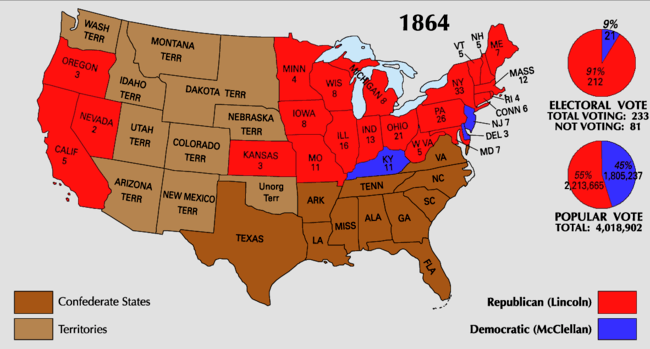
While the war was still being waged, Lincoln faced reelection in 1864. Lincoln was a master politician, bringing together—and holding together—all the main factions of the Republican Party, and bringing in War Democrats such as Edwin M. Stanton and Andrew Johnson as well. Lincoln spent many hours a week talking to politicians from across the land and using his patronage powers—greatly expanded over peacetime—to hold the factions of his party together, build support for his own policies, and fend off efforts by Radicals to drop him from the 1864 ticket.[281][282] At its 1864 convention, the Republican Party selected Johnson, a War Democrat from the Southern state of Tennessee, as his running mate. To broaden his coalition to include War Democrats as well as Republicans, Lincoln ran under the label of the new Union Party.[283]
When Grant's 1864 spring campaigns turned into bloody stalemates and Union casualties mounted, the lack of military success wore heavily on the President's re-election prospects, and many Republicans across the country feared that Lincoln would be defeated. Sharing this fear, Lincoln wrote and signed a pledge that, if he should lose the election, he would still defeat the Confederacy before turning over the White House:[284]
This morning, as for some days past, it seems exceedingly probable that this Administration will not be re-elected. Then it will be my duty to so co-operate with the President elect, as to save the Union between the election and the inauguration; as he will have secured his election on such ground that he cannot possibly save it afterward.[285]
Lincoln did not show the pledge to his cabinet, but asked them to sign the sealed envelope.
While the Democratic platform followed the "Peace wing" of the party and called the war a "failure", their candidate, General George B. McClellan, supported the war and repudiated the platform. Lincoln provided Grant with more troops and mobilized his party to renew its support of Grant in the war effort. Sherman's capture of Atlanta in September and David Farragut's capture of Mobile ended defeatist jitters;[286] the Democratic Party was deeply split, with some leaders and most soldiers openly for Lincoln. By contrast, the National Union Party was united and energized as Lincoln made emancipation the central issue, and state Republican parties stressed the perfidy of the Copperheads.[287] On November 8, Lincoln was re-elected in a landslide, carrying all but three states, and receiving 78 percent of the Union soldiers' vote.[284][288]
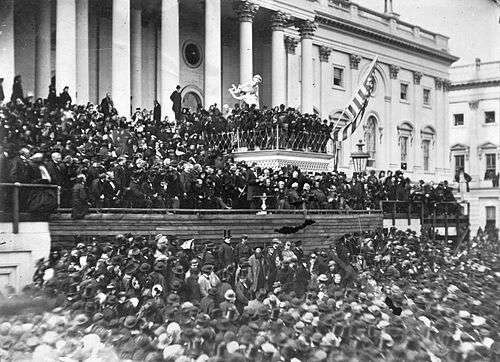
On March 4, 1865, Lincoln delivered his second inaugural address. In it, he deemed the high casualties on both sides to be God's will. Historian Mark Noll concludes it ranks "among the small handful of semi-sacred texts by which Americans conceive their place in the world".[289] Lincoln said:
Fondly do we hope—fervently do we pray—that this mighty scourge of war may speedily pass away. Yet, if God wills that it continue, until all the wealth piled by the bond-man's 250 years of unrequited toil shall be sunk, and until every drop of blood drawn with the lash, shall be paid by another drawn with the sword, as was said 3,000 years ago, so still it must be said, "the judgments of the Lord, are true and righteous altogether". With malice toward none; with charity for all; with firmness in the right, as God gives us to see the right, let us strive on to finish the work we are in; to bind up the nation's wounds; to care for him who shall have borne the battle, and for his widow, and his orphan—to do all which may achieve and cherish a just and lasting peace, among ourselves, and with all nations.[290]
Reconstruction
Reconstruction began during the war, as Lincoln and his associates anticipated questions of how to reintegrate the conquered southern states, and how to determine the fates of Confederate leaders and freed slaves. Shortly after Lee's surrender, a general had asked Lincoln how the defeated Confederates should be treated, and Lincoln replied, "Let 'em up easy."[291] In keeping with that sentiment, Lincoln led the moderates regarding Reconstruction policy, and was opposed by the Radical Republicans, under Rep. Thaddeus Stevens, Sen. Charles Sumner and Sen. Benjamin Wade, political allies of the president on other issues. Determined to find a course that would reunite the nation and not alienate the South, Lincoln urged that speedy elections under generous terms be held throughout the war. His Amnesty Proclamation of December 8, 1863, offered pardons to those who had not held a Confederate civil office, had not mistreated Union prisoners, and would sign an oath of allegiance.[292]
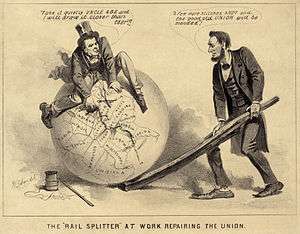
As Southern states were subdued, critical decisions had to be made as to their leadership while their administrations were re-formed. Of special importance were Tennessee and Arkansas, where Lincoln appointed Generals Andrew Johnson and Frederick Steele as military governors, respectively. In Louisiana, Lincoln ordered General Nathaniel P. Banks to promote a plan that would restore statehood when 10 percent of the voters agreed to it. Lincoln's Democratic opponents seized on these appointments to accuse him of using the military to ensure his and the Republicans' political aspirations. On the other hand, the Radicals denounced his policy as too lenient, and passed their own plan, the Wade-Davis Bill, in 1864. When Lincoln vetoed the bill, the Radicals retaliated by refusing to seat representatives elected from Louisiana, Arkansas, and Tennessee.[293]
Lincoln's appointments were designed to keep both the moderate and Radical factions in harness. To fill Chief Justice Taney's seat on the Supreme Court, he named the choice of the Radicals, Salmon P. Chase, who Lincoln believed would uphold the emancipation and paper money policies.[294]
After implementing the Emancipation Proclamation, which did not apply to every state, Lincoln increased pressure on Congress to outlaw slavery throughout the entire nation with a constitutional amendment. Lincoln declared that such an amendment would "clinch the whole matter".[295] By December 1863, a proposed constitutional amendment that would outlaw slavery was brought to Congress for passage. This first attempt at an amendment failed to pass, falling short of the required two-thirds majority on June 15, 1864, in the House of Representatives. Passage of the proposed amendment became part of the Republican/Unionist platform in the election of 1864. After a long debate in the House, a second attempt passed Congress on January 31, 1865, and was sent to the state legislatures for ratification.[296][297] Upon ratification, it became the Thirteenth Amendment to the United States Constitution on December 6, 1865.[298]
As the war drew to a close, Lincoln's presidential Reconstruction for the South was in flux; having believed the federal government had limited responsibility to the millions of freedmen. He signed into law Senator Charles Sumner's Freedmen's Bureau bill that set up a temporary federal agency designed to meet the immediate material needs of former slaves. The law assigned land for a lease of three years with the ability to purchase title for the freedmen. Lincoln stated that his Louisiana plan did not apply to all states under Reconstruction. Shortly before his assassination, Lincoln announced he had a new plan for southern Reconstruction. Discussions with his cabinet revealed Lincoln planned short-term military control over southern states, until readmission under the control of southern Unionists.[299]
Historians agree that it is impossible to predict exactly what Lincoln would have done about Reconstruction if he had lived, but they make projections based on his known policy positions and political acumen. Lincoln biographers James G. Randall and Richard Current, according to David Lincove, argue that:[300]
It is likely that had he lived, Lincoln would have followed a policy similar to Johnson's, that he would have clashed with congressional Radicals, that he would have produced a better result for the freedmen than occurred, and that his political skills would have helped him avoid Johnson's mistakes.
Eric Foner argues that:[301]
Unlike Sumner and other Radicals, Lincoln did not see Reconstruction as an opportunity for a sweeping political and social revolution beyond emancipation. He had long made clear his opposition to the confiscation and redistribution of land. He believed, as most Republicans did in April 1865, that the voting requirements should be determined by the states. He assumed that political control in the South would pass to white Unionists, reluctant secessionists, and forward-looking former Confederates. But time and again during the war, Lincoln, after initial opposition, had come to embrace positions first advanced by abolitionists and Radical Republicans. ... Lincoln undoubtedly would have listened carefully to the outcry for further protection for the former slaves ... It is entirely plausible to imagine Lincoln and Congress agreeing on a Reconstruction policy that encompassed federal protection for basic civil rights plus limited black suffrage, along the lines Lincoln proposed just before his death.
Redefining the republic and republicanism

The successful reunification of the states had consequences for the name of the country. The term "the United States" has historically been used, sometimes in the plural ("these United States"), and other times in the singular, without any particular grammatical consistency. The Civil War was a significant force in the eventual dominance of the singular usage by the end of the 19th century.[302]
In recent years, historians such as Harry Jaffa, Herman Belz, John Diggins, Vernon Burton and Eric Foner have stressed Lincoln's redefinition of republican values. As early as the 1850s, a time when most political rhetoric focused on the sanctity of the Constitution, Lincoln redirected emphasis to the Declaration of Independence as the foundation of American political values—what he called the "sheet anchor" of republicanism.[303] The Declaration's emphasis on freedom and equality for all, in contrast to the Constitution's tolerance of slavery, shifted the debate. As Diggins concludes regarding the highly influential Cooper Union speech of early 1860, "Lincoln presented Americans a theory of history that offers a profound contribution to the theory and destiny of republicanism itself."[304] His position gained strength because he highlighted the moral basis of republicanism, rather than its legalisms.[305] Nevertheless, in 1861, Lincoln justified the war in terms of legalisms (the Constitution was a contract, and for one party to get out of a contract all the other parties had to agree), and then in terms of the national duty to guarantee a republican form of government in every state.[306] Burton (2008) argues that Lincoln's republicanism was taken up by the Freedmen as they were emancipated.[307]
In March 1861, in Lincoln's first inaugural address, he explored the nature of democracy. He denounced secession as anarchy, and explained that majority rule had to be balanced by constitutional restraints in the American system. He said "A majority held in restraint by constitutional checks and limitations, and always changing easily with deliberate changes of popular opinions and sentiments, is the only true sovereign of a free people."[308]
Other enactments
Lincoln adhered to the Whig theory of the presidency, which gave Congress primary responsibility for writing the laws while the Executive enforced them. Lincoln vetoed only four bills passed by Congress; the only important one was the Wade-Davis Bill with its harsh program of Reconstruction.[309] He signed the Homestead Act in 1862, making millions of acres of government-held land in the West available for purchase at very low cost. The Morrill Land-Grant Colleges Act, also signed in 1862, provided government grants for agricultural colleges in each state. The Pacific Railway Acts of 1862 and 1864 granted federal support for the construction of the United States' First Transcontinental Railroad, which was completed in 1869.[310] The passage of the Homestead Act and the Pacific Railway Acts was made possible by the absence of Southern congressmen and senators who had opposed the measures in the 1850s.[311]
| The Lincoln Cabinet[312] | ||
|---|---|---|
| Office | Name | Term |
| President | Abraham Lincoln | 1861–1865 |
| Vice President | Hannibal Hamlin | 1861–1865 |
| Andrew Johnson | 1865 | |
| Secretary of State | William H. Seward | 1861–1865 |
| Secretary of Treasury | Salmon P. Chase | 1861–1864 |
| Hugh McCulloch | 1865 | |
| William P. Fessenden | 1864–1865 | |
| Secretary of War | Simon Cameron | 1861–1862 |
| Edwin M. Stanton | 1862–1865 | |
| Attorney General | Edward Bates | 1861–1864 |
| James Speed | 1864–1865 | |
| Postmaster General | Montgomery Blair | 1861–1864 |
| William Dennison Jr. | 1864–1865 | |
| Secretary of the Navy | Gideon Welles | 1861–1865 |
| Secretary of the Interior | Caleb Blood Smith | 1861–1862 |
| John Palmer Usher | 1863–1865 | |
Other important legislation involved two measures to raise revenues for the Federal government: tariffs (a policy with long precedent), and a new Federal income tax. In 1861, Lincoln signed the second and third Morrill Tariff, the first having become law under James Buchanan. Also in 1861, Lincoln signed the Revenue Act of 1861, creating the first U.S. income tax.[313] This created a flat tax of 3 percent on incomes above $800 ($21,800 in current dollar terms), which was later changed by the Revenue Act of 1862 to a progressive rate structure.[314]
Lincoln also presided over the expansion of the federal government's economic influence in several other areas. The creation of the system of national banks by the National Banking Act provided a strong financial network in the country. It also established a national currency. In 1862, Congress created, with Lincoln's approval, the Department of Agriculture.[315] In 1862, Lincoln sent a senior general, John Pope, to put down the "Sioux Uprising" in Minnesota. Presented with 303 execution warrants for convicted Santee Dakota who were accused of killing innocent farmers, Lincoln conducted his own personal review of each of these warrants, eventually approving 39 for execution (one was later reprieved).[316] President Lincoln had planned to reform federal Indian policy.[317]
In the wake of Grant's casualties in his campaign against Lee, Lincoln had considered yet another executive call for a military draft, but it was never issued. In response to rumors of one, however, the editors of the New York World and the Journal of Commerce published a false draft proclamation which created an opportunity for the editors and others employed at the publications to corner the gold market. Lincoln's reaction was to send the strongest of messages to the media about such behavior; he ordered the military to seize the two papers. The seizure lasted for two days.[318]
Lincoln is largely responsible for the institution of the Thanksgiving holiday in the United States.[319] Before Lincoln's presidency, Thanksgiving, while a regional holiday in New England since the 17th century, had been proclaimed by the federal government only sporadically and on irregular dates. The last such proclamation had been during James Madison's presidency 50 years before. In 1863, Lincoln declared the final Thursday in November of that year to be a day of Thanksgiving.[319] In June 1864, Lincoln approved the Yosemite Grant enacted by Congress, which provided unprecedented federal protection for the area now known as Yosemite National Park.[320]
Judicial appointments
Supreme Court appointments
- Noah Haynes Swayne – 1862
- Samuel Freeman Miller – 1862
- David Davis – 1862
- Stephen Johnson Field – 1863
- Salmon Portland Chase – 1864 (Chief Justice)
.jpg)
Lincoln's declared philosophy on court nominations was that "we cannot ask a man what he will do, and if we should, and he should answer us, we should despise him for it. Therefore we must take a man whose opinions are known."[319] Lincoln made five appointments to the United States Supreme Court. Noah Haynes Swayne, nominated January 21, 1862, and appointed January 24, 1862, was chosen as an anti-slavery lawyer who was committed to the Union. Samuel Freeman Miller, nominated and appointed on July 16, 1862, supported Lincoln in the 1860 election and was an avowed abolitionist. David Davis, Lincoln's campaign manager in 1860, nominated December 1, 1862, and appointed December 8, 1862, had also served as a judge in Lincoln's Illinois court circuit. Stephen Johnson Field, a previous California Supreme Court justice, was nominated March 6, 1863, and appointed March 10, 1863, and provided geographic balance, as well as political balance to the court as a Democrat. Finally, Lincoln's Treasury Secretary, Salmon P. Chase, was nominated as Chief Justice, and appointed the same day, on December 6, 1864. Lincoln believed Chase was an able jurist, would support Reconstruction legislation, and that his appointment united the Republican Party.[321]
Other judicial appointments
Lincoln appointed 32 federal judges, including four Associate Justices and one Chief Justice to the Supreme Court of the United States, and 27 judges to the United States district courts. Lincoln appointed no judges to the United States circuit courts during his time in office.[322][323]
States admitted to the Union
West Virginia, admitted to the Union June 20, 1863, contained the former north-westernmost counties of Virginia that seceded from Virginia after that commonwealth declared its secession from the Union. As a condition for its admission, West Virginia's constitution was required to provide for the gradual abolition of slavery. Nevada, which became the third State in the far-west of the continent, was admitted as a free state on October 31, 1864.[324]
Assassination and funeral


Abraham Lincoln was assassinated by John Wilkes Booth on Good Friday, April 14, 1865, while attending a play at Ford's Theatre as the American Civil War was drawing to a close. The assassination occurred five days after the surrender of Robert E. Lee and the Confederate Army of Northern Virginia. Booth was a well-known actor and a Confederate spy from Maryland; though he never joined the Confederate army, he had contacts with the Confederate secret service.[325] In 1864, Booth formulated a plan (very similar to one of Thomas N. Conrad previously authorized by the Confederacy)[326] to kidnap Lincoln in exchange for the release of Confederate prisoners. After attending an April 11, 1865, speech in which Lincoln promoted voting rights for blacks, an incensed Booth changed his plans and became determined to assassinate the president.[327] Learning that the President and Grant would be attending Ford's Theatre, Booth formulated a plan with co-conspirators to assassinate Lincoln and Grant at the theater, as well as Vice President Johnson and Secretary of State Seward at their homes. Without his main bodyguard, Ward Hill Lamon, Lincoln left to attend the play Our American Cousin on April 14. At the last minute, Grant decided to go to New Jersey to visit his children instead of attending the play.[328]
Lincoln's bodyguard, John Parker, left Ford's Theater during intermission to drink at the saloon next door. The now unguarded President sat in his state box in the balcony. Seizing the opportunity, Booth crept up from behind and at about 10:13 pm, aimed at the back of Lincoln's head and fired at point-blank range, mortally wounding the President. Major Henry Rathbone momentarily grappled with Booth, but Booth stabbed him and escaped.[329][330]
After being on the run for 12 days, Booth was tracked down and found on a farm in Virginia, some 70 miles (110 km) south of Washington. After refusing to surrender to Union troops, Booth was killed by Sergeant Boston Corbett on April 26.[331][332]
Doctor Charles Leale, an Army surgeon, found the President unresponsive, barely breathing and with no detectable pulse. Having determined that the President had been shot in the head, and not stabbed in the shoulder as originally thought, he made an attempt to clear the blood clot, after which the President began to breathe more naturally.[333] The dying President was taken across the street to Petersen House. After remaining in a coma for nine hours, Lincoln died at 7:22 am on April 15. According to eyewitnesses, he face was fixed in a smile when he expired.[334][335][336][337] Secretary of War Stanton saluted and said, "Now he belongs to the ages."[338]
Lincoln's flag-enfolded body was then escorted in the rain to the White House by bareheaded Union officers, while the city's church bells rang. President Johnson was sworn in at 10:00 am, less than 3 hours after Lincoln's death. The late President lay in state in the East Room, and then in the Capitol Rotunda from April 19 through April 21. For his final journey with his son Willie, both caskets were transported in the executive coach "United States" and for three weeks the Lincoln Special funeral train decorated in black bunting[339] bore Lincoln's remains on a slow circuitous waypoint journey from Washington D.C. to Springfield, Illinois, stopping at many cities across the North for large-scale memorials attended by hundreds of thousands, as well as many people who gathered in informal trackside tributes with bands, bonfires, and hymn singing[340][341] or silent reverence with hat in hand as the railway procession slowly passed by. Poet Walt Whitman composed When Lilacs Last in the Dooryard Bloom'd to eulogize Lincoln, one of four poems he wrote about the assassinated president.[342] Historians have emphasized the widespread shock and sorrow, but also noted that some Lincoln haters cheered when they heard the news.[343] African-Americans were especially moved; they had lost 'their Moses'.[344] In a larger sense, the outpouring of grief and anguish was in response to the deaths of so many men in the war that had just ended.[345]
Religious and philosophical beliefs
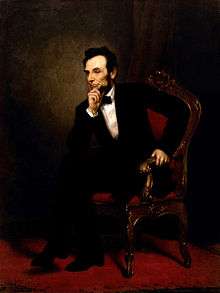
As a young man, Lincoln was a religious skeptic,[346] or, in the words of a biographer, an iconoclast.[347] Later in life, Lincoln's frequent use of religious imagery and language might have reflected his own personal beliefs or might have been a device to appeal to his audiences, who were mostly evangelical Protestants.[348] He never joined a church, although he frequently attended with his wife.[349] However, he was deeply familiar with the Bible, and he both quoted and praised it.[350] He was private about his beliefs and respected the beliefs of others. Lincoln never made a clear profession of Christian beliefs. However, he did believe in an all-powerful God that shaped events and, by 1865, was expressing those beliefs in major speeches.[351]
In the 1840s, Lincoln subscribed to the Doctrine of Necessity, a belief that asserted the human mind was controlled by some higher power.[352] In the 1850s, Lincoln believed in "providence" in a general way, and rarely used the language or imagery of the evangelicals; he regarded the republicanism of the Founding Fathers with an almost religious reverence.[353] When he suffered the death of his son Edward, Lincoln more frequently expressed a need to depend on God.[354] The death of his son Willie in February 1862 may have caused Lincoln to look toward religion for answers and solace.[355] After Willie's death, Lincoln considered why, from a divine standpoint, the severity of the war was necessary. He wrote at this time that God "could have either saved or destroyed the Union without a human contest. Yet the contest began. And having begun, He could give the final victory to either side any day. Yet the contest proceeds."[356] On the day Lincoln was assassinated, he reportedly told his wife he desired to visit the Holy Land.[357]
Health
Several claims abound that Lincoln's health was declining before the assassination. These are often based on photographs appearing to show weight loss and muscle wasting. One such claim is that he suffered from a rare genetic disorder, MEN2b,[358] which manifests with a medullary thyroid carcinoma, mucosal neuromas and a Marfanoid appearance. Others simply claim he had Marfan syndrome, based on his tall appearance with spindly fingers, and the association of possible aortic regurgitation, which can cause bobbing of the head (DeMusset's sign) – based on blurring of Lincoln's head in photographs, which back then had a long exposure time. As of 2009, DNA analysis was being refused by the Grand Army of the Republic museum in Philadelphia.[358]
Historical reputation
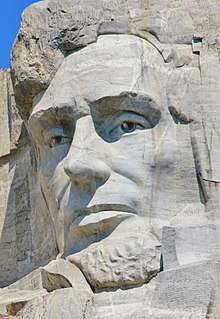
In surveys of U.S. scholars ranking presidents conducted since the 1940s, Lincoln is consistently ranked in the top three, often as number one.[5][6] A 2004 study found that scholars in the fields of history and politics ranked Lincoln number one, while legal scholars placed him second after Washington.[359] In presidential ranking polls conducted in the United States since 1948, Lincoln has been rated at the very top in the majority of polls. Generally, the top three presidents are rated as 1. Lincoln; 2. George Washington; and 3. Franklin D. Roosevelt, although Lincoln and Washington, and Washington and Roosevelt, are occasionally reversed.[360]
President Lincoln's assassination increased his status to the point of making him a national martyr. Lincoln was viewed by abolitionists as a champion for human liberty. Republicans linked Lincoln's name to their party. Many, though not all, in the South considered Lincoln as a man of outstanding ability.[361] Historians have said he was "a classical liberal" in the 19th century sense. Allen C. Guelzo states that Lincoln was a[362][363]
classical liberal democrat—an enemy of artificial hierarchy, a friend to trade and business as ennobling and enabling, and an American counterpart to Mill, Cobden, and Bright (whose portrait Lincoln hung in his White House office).
Lincoln became a favorite exemplar for liberal intellectuals across Europe and Latin America and even in Asia.[364]
Schwartz argues that Lincoln's American reputation grew slowly in the late 19th century until the Progressive Era (1900–1920s) when he emerged as one of the most venerated heroes in American history, with even white Southerners in agreement. The high point came in 1922 with the dedication of the Lincoln Memorial on the National Mall in Washington, D.C.[365] In the New Deal era liberals honored Lincoln not so much as the self-made man or the great war president, but as the advocate of the common man who they believe would have supported the welfare state. In the Cold War years, Lincoln's image shifted to emphasize the symbol of freedom who brought hope to those oppressed by communist regimes.[366]
By the 1970s Lincoln had become a hero to political conservatives[367] for his intense nationalism, support for business, his insistence on stopping the spread of human bondage, his acting in terms of Lockean and Burkean principles on behalf of both liberty and tradition, and his devotion to the principles of the Founding Fathers.[368][369][370] As a Whig activist, Lincoln was a spokesman for business interests, favoring high tariffs, banks, internal improvements, and railroads in opposition to the agrarian Democrats.[371] William C. Harris found that Lincoln's "reverence for the Founding Fathers, the Constitution, the laws under it, and the preservation of the Republic and its institutions undergirded and strengthened his conservatism".[372] James G. Randall emphasizes his tolerance and especially his moderation "in his preference for orderly progress, his distrust of dangerous agitation, and his reluctance toward ill digested schemes of reform". Randall concludes that, "he was conservative in his complete avoidance of that type of so-called 'radicalism' which involved abuse of the South, hatred for the slaveholder, thirst for vengeance, partisan plotting, and ungenerous demands that Southern institutions be transformed overnight by outsiders."[373]
By the late 1960s, some African American intellectuals led by Lerone Bennett Jr., rejected Lincoln's role as the Great Emancipator.[374][375] Bennett won wide attention when he called Lincoln a white supremacist in 1968.[376] He noted that Lincoln used ethnic slurs and told jokes that ridiculed blacks. Bennett argued that Lincoln opposed social equality, and proposed sending freed slaves to another country. Defenders, such as authors Dirck and Cashin, retorted that he was not as bad as most politicians of his day;[377] and that he was a "moral visionary" who deftly advanced the abolitionist cause, as fast as politically possible.[378] The emphasis shifted away from Lincoln-the-emancipator to an argument that blacks had freed themselves from slavery, or at least were responsible for pressuring the government on emancipation.[379][380] Historian Barry Schwartz wrote in 2009 that Lincoln's image suffered "erosion, fading prestige, benign ridicule" in the late 20th century.[381] On the other hand, Donald opined in his 1996 biography that Lincoln was distinctly endowed with the personality trait of negative capability, defined by the poet John Keats and attributed to extraordinary leaders who were "content in the midst of uncertainties and doubts, and not compelled toward fact or reason".[382] In the 21st century, President Barack Obama named Lincoln his favorite president and insisted on using Lincoln's Bible for his swearing in to office at both his inaugurations.[383][384][385]
Lincoln has often been portrayed by Hollywood, almost always in a flattering light.[386][387]
The Union nationalism as envisioned by Lincoln, "helped lead America to the nationalism of Theodore Roosevelt, Woodrow Wilson, and Franklin Delano Roosevelt."[388]
Memory and memorials
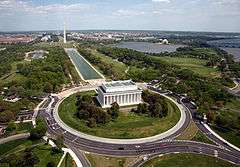
Lincoln's portrait appears on two denominations of United States currency, the penny and the $5 bill. His likeness also appears on many postage stamps and he has been memorialized in many town, city, and county names,[389] including the capital of Nebraska.[390] While he is usually portrayed bearded, he first grew a beard in 1860 at the suggestion of 11-year-old Grace Bedell.
The most famous and most visited memorials are Lincoln's sculpture on Mount Rushmore;[391] Lincoln Memorial, Ford's Theatre, and Petersen House (where he died) in Washington, D.C.; and the Abraham Lincoln Presidential Library and Museum in Springfield, Illinois, not far from Lincoln's home, as well as his tomb.[392][393]
There was also the Great Moments with Mr. Lincoln exhibit in Disneyland, and Hall of Presidents at Walt Disney World, which had to do with Walt Disney admiring Lincoln ever since he was a little boy.
Barry Schwartz, a sociologist who has examined America's cultural memory, argues that in the 1930s and 1940s, the memory of Abraham Lincoln was practically sacred and provided the nation with "a moral symbol inspiring and guiding American life". During the Great Depression, he argues, Lincoln served "as a means for seeing the world's disappointments, for making its sufferings not so much explicable as meaningful". Franklin D. Roosevelt, preparing America for war, used the words of the Civil War president to clarify the threat posed by Germany and Japan. Americans asked, "What would Lincoln do?"[394] However, Schwartz also finds that since World War II, Lincoln's symbolic power has lost relevance, and this "fading hero is symptomatic of fading confidence in national greatness". He suggested that postmodernism and multiculturalism have diluted greatness as a concept.[395]
The United States Navy Nimitz-class aircraft carrier USS Abraham Lincoln (CVN-72) is named after Lincoln, the second Navy ship to bear his name.
See also
Notes
References
- ↑ Carpenter, Francis B. (1866). Six Months in the White House: The Story of a Picture. Hurd and Houghton. p. 217.
- ↑ William A. Pencak (2009). Encyclopedia of the Veteran in America. ABC-CLIO. p. 222. ISBN 978-0-313-08759-2. Retrieved June 27, 2015.
- ↑ Paul Finkelman; Stephen E. Gottlieb (2009). Toward a Usable Past: Liberty Under State Constitutions. U of Georgia Press. p. 388. ISBN 978-0-8203-3496-7. Archived from the original on September 5, 2015. Retrieved June 27, 2015.
- ↑ Randall (1947), pp. 65–87.
- 1 2 "Ranking Our Presidents" for dealing with the American Civil War, and slavery. Archived January 31, 2012, at the Wayback Machine.. James Lindgren. November 16, 2000. International World History Project.
- 1 2 "Americans Say Reagan Is the Greatest President" Archived March 14, 2012, at the Wayback Machine.. Gallup Inc. February 28, 2011.
- ↑ Donald (1996), pp. 20–22.
- ↑ Louis A. Warren (1991). Lincoln's Youth: Indiana Years, Seven to Twenty-One, 1816–1830. Indianapolis: Indiana Historical Society. pp. 3–4. ISBN 978-0-87195-063-5.
- ↑ Donald (1996), p. 20.
- ↑ Warren, p. 4.
- ↑ Wilson, Douglas Lawson; Davis, Rodney O.; Wilson, Terry; Herndon, William Henry; Weik, Jesse William (1998). Herndon's Informants: Letters, Interviews, and Statements about Abraham Lincoln. University of Illinois Press. pp. 35–36. ISBN 978-0-252-02328-6. Archived from the original on January 13, 2018.
- ↑ Thomas, born January 1778, would have been 8 at the attack, May 1786. Older sources (e.g. Herndon's Informants[11]) use six.
- ↑ Donald (1996), p. 21.
- ↑ Michael Burlingame (2008). Abraham Lincoln: A Life. I. Baltimore, MD: Johns Hopkins University Press. pp. 1–2. ISBN 978-0-8018-8993-6.
- ↑ White, pp. 12–13.
- ↑ Warren, p. 5.
- ↑ Donald (1996), p. 21.
- ↑ William E. Bartelt (2008). There I Grew Up: Remembering Abraham Lincoln's Indiana Youth. Indianapolis: Indiana Historical Society Press. p. 79. ISBN 978-0-87195-263-9.
- ↑ Lincoln, Eilliam Ensign (1909). The Ancestry of Abraham Lincoln. Boston: Houghton Mifflin Co. p. 85.
- ↑ Adin Baber (2004). The Hanks Family of Virginia and Westward: a genealogical record from the early 1600s, including charts of families in Arkansas, the Carolina, Georgia, Illinois, Indiana, Iowa, Kentucky, Missouri, Oklahoma, Ohio, Pennsylvania, Texas, and west to the Pacific Ocean and beyond. Carpenterina, CA: Nancy Baber McNeil. p. 154. ISBN 978-0-87062-334-9.
- ↑ Warren, p. 9.
- ↑ Warren, p. 9–10.
- ↑ Bartelt, p. 14.
- 1 2 Warren, p. 12.
- 1 2 Sandburg (1926), p. 20.
- ↑ Warren, p. 13.
- ↑ Warren, p. 26.
- ↑ Warren, p. 16 and 43.
- ↑ Bartelt, p. 3, 5, and 16.
- ↑ Donald (1996), p. 23–24.
- ↑ Bartelt, p. 34 and 156.
- ↑ Donald (1996), pp. 22–24.
- ↑ Bartelt, p. 24 and 104.
- ↑ Bartelt, p. 25 and 71.
- ↑ Bartelt, p. 22–23, and 77.
- ↑ Bartelt, p. 23 and 83.
- ↑ Donald (1996), pp. 26–27.
- ↑ Bartelt, p. 10.
- ↑ Donald (1996), p. 20, 30–33.
- ↑ Bartelt, p. 37.
- ↑ William Lee Miller (2002). Lincoln's Virtues: An Ethical Biography (Vintage Books ed.). New York: Random House/Vintage Books. p. 31. ISBN 978-0-375-40158-9.
- ↑ White, pp. 25, 31, and 47.
- ↑ Donald (1996), p. 33.
- ↑ Bartelt, p. 66.
- ↑ Bartelt, p. 10 and 33.
- ↑ James H. Madison (2014). Hoosiers: A New History of Indiana. Bloomington and Indianapolis: Indiana University Press and Indiana Historical Society Press. p. 110. ISBN 978-0-253-01308-8.
- ↑ Donald (1996), pp. 29–31, 38–43
- ↑ Merrill D. Peterson (1995). Lincoln in American Memory. Oxford U.P. p. 110. ISBN 978-0-19-988002-7. Retrieved June 27, 2015.
- ↑ Bartelt, p. 118, 143, and 148.
- ↑ Warren, p. xix, 30, 46, and 48.
- ↑ Donald (1996), pp. 30–33.
- ↑ Warren, p. 134–35.
- ↑ Donald (1996), p. 41.
- ↑ Donald (1996), p. 36.
- ↑ Bartelt, p. 41 and 63.
- ↑ Bartelt, p. 38–40.
- ↑ Bartelt, p. 71.
- ↑ Donald (1996), p. 28 and 152.
- ↑ Stephen B. Oates (1994). With Malice Toward None: The Life of Abraham Lincoln. New York: HarperPerennial. pp. 15–17. ISBN 978-0-06-092471-3.
- ↑ Thomas (2008), pp. 23–53
- ↑ Sandburg (1926), pp. 22–23.
- ↑ Donald (1996), p. 38.
- ↑ Gannett, Lewis (Winter 2005). ""Overwhelming Evidence" of a Lincoln-Ann Rutledge Romance?: Reexamining Rutledge Family Reminiscences". Journal of the Abraham Lincoln Association. Springfield, IL: The Abraham Lincoln Association. pp. 28–41. Archived from the original on April 3, 2017.
- ↑ Donald (1996), pp. 55–58.
- 1 2 Donald (1996), pp. 67–69; Thomas (2008), pp. 56–57, 69–70.
- ↑ Lamb, p. 43.
- 1 2 Sandburg (1926), pp. 46–48.
- ↑ Donald (1996), p. 86.
- ↑ Donald (1996), p. 87.
- ↑ Sandburg (1926), pp. 50–51.
- ↑ Donald (1996), p. 93.
- ↑ Baker, p. 142.
- ↑ White, pp. 179–181, 476.
- ↑ Jason Emerson (2012). Giant in the Shadows: The Life of Robert T. Lincoln. SIU Press. p. 420. ISBN 978-0-8093-3055-3. Retrieved June 27, 2015.
- ↑ White, p. 126.
- ↑ Baker, p. 120.
- ↑ Shenk, Joshua Wolf (October 2005). "Lincoln's Great Depression". The Atlantic. The Atlantic Monthly Group. Archived from the original on October 20, 2011. Retrieved October 8, 2009.
- ↑ Steers, p. 341.
- ↑ Foner (1995), pp. 440–447.
- ↑ Olver, Lynne. "The Food Timeline—Presidents food favorites". foodtimeline.org. Archived from the original on February 4, 2016. Retrieved February 12, 2016.
- ↑ Kenneth J. Winkle (2001). The Young Eagle: The Rise of Abraham Lincoln. Taylor. pp. 72–79. ISBN 978-1-4617-3436-9. Retrieved June 27, 2015.
- ↑ Donald (1996), pp. 40–42.
- ↑ s:Life and Works of Abraham Lincoln/Volume 3/The Improvement of Sangamon River
- ↑ Winkle, pp. 86–95.
- ↑ Sandburg (2002), p. 14
- ↑ Donald (1996), p. 46.
- ↑ Winkle, pp. 114–116.
- ↑ Donald (1996), pp. 53–55.
- ↑ White, p. 59.
- ↑ Donald (1996), p. 64.
- ↑ White, pp. 71, 79, 108.
- ↑ Donald (1948), p. 17.
- ↑ Simon, p. 283.
- ↑ Weik, Jesse William. "Abraham Lincoln and Internal Improvements". Abraham Lincoln's Classroom. Archived from the original on February 12, 2015. Retrieved February 12, 2015.
- ↑ Simon, p. 130.
- ↑ Donald (1996), p. 134.
- ↑ Foner (2010), pp. 17–19, 67.
- ↑ Donald (1996), p. 222.
- ↑ Boritt (1994), pp. 137–153.
- ↑ White, pp. 123–124.
- ↑ Oates, p. 79.
- ↑ Harris, p. 54; Foner (2010), p. 57.
- ↑ Heidler (2006), pp. 181–183.
- ↑ Holzer, p. 63.
- ↑ Abraham Lincoln, Spot Resolutions in the United States House of Representatives, December 22, 1847, National Archives Building, RG 233, Entry 362: Thirtieth Congress, 1847–1849, Records of Legislative Proceedings, Bills and Resolutions Originating in the House, 1847–1849
- ↑ Oates, pp. 79–80.
- 1 2 Basler (1946), pp. 199–202.
- ↑ Gerleman, (2017) "Representative Lincoln at Work," 40.
- ↑ McGovern, p. 33.
- ↑ Basler (1946), p. 202.
- ↑ "Lincoln's Spot Resolutions". National Archives. Archived from the original on October 20, 2011. Retrieved March 12, 2009.
- ↑ Donald (1996), p. 128.
- ↑ Donald (1996), pp. 124–126.
- ↑ Donald (1996), p. 140.
- ↑ Arnold, Isaac Newton (1885). The Life of Abraham Lincoln. 2. Chicago, IL: Janses, McClurg, & Company. p. 81. Archived from the original on April 3, 2017.
- ↑ Harris, pp. 55–57.
- ↑ Donald (1996), p. 96.
- ↑ Donald (1996), pp. 105–106, 158.
- ↑ Donald (1996), pp. 142–143.
- ↑ Bridging the Mississippi Archived September 23, 2008, at the Wayback Machine.. Archives.gov (October 19, 2011). Retrieved August 17, 2013.
- ↑
- Brian McGinty, Lincoln's Greatest Case: The River, the Bridge, and the Making of America (2015)
- ↑ White, p. 163.
- ↑ "Abraham Lincoln's Patent Model: Improvement for Buoying Vessels Over Shoals". Smithsonian Institution. Archived from the original on August 25, 2017. Retrieved April 28, 2017.
- 1 2 Donald (1996), p. 155.
- ↑ Dirck (2007), p. 92.
- ↑ Handy, p. 440.
- ↑ Donald (1996), pp. 155–156, 196–197.
- ↑ Philosophical Library (2010). The Wisdom of Abraham Lincoln. Open Road Media. p. 1828. ISBN 978-1-4532-0281-4.
- 1 2 3 Donald (1996), pp. 150–151.
- ↑ Harrison (1935), p. 270.
- ↑ White, pp. 175–176.
- ↑ White, pp. 182–185.
- ↑ White, pp. 188–190.
- ↑ White, pp. 196–197.
- ↑ Thomas (2008), pp. 148–152.
- ↑ White, p. 199.
- ↑ Basler (1953), p. 255.
- 1 2 White, pp. 203–205.
- ↑ White, pp. 215–216.
- ↑ McGovern, pp. 38–39.
- ↑ White, pp. 203–204.
- ↑ White, pp. 191–194.
- ↑ White, pp. 204–205.
- ↑ Oates, p. 119.
- ↑ White, pp. 205–208.
- ↑ White, pp. 216–221.
- ↑ White, pp. 224–228.
- ↑ White, pp. 229–230.
- ↑ Foner (2010), pp. 84–88.
- ↑ White, pp. 236–238.
- ↑ Zarefsky, pp. 69–110.
- ↑ Jaffa, pp. 299–300.
- 1 2 White, pp. 247–248.
- ↑ Oates, pp. 138–139.
- ↑ White, pp. 247–250.
- ↑ White, p. 251.
- ↑ Harris, p. 98.
- ↑ Donald (1996), p. 209.
- ↑ White, pp. 257–258.
- ↑ McPherson (1993), p. 182.
- ↑ Donald (1996), pp. 214–224.
- ↑ Donald (1996), p. 223.
- ↑ Carwardine (2003), pp. 89–90.
- ↑ Donald (1996), pp. 242, 412.
- ↑ White, pp. 291–293.
- ↑ White, pp. 307–308.
- ↑ Jaffa, p. 473.
- ↑ Holzer, pp. 108–111.
- ↑ Carwardine (2003), p. 97.
- ↑ Holzer, p. 157.
- ↑ Donald (1996), p. 240.
- ↑ Donald (1996), p. 241.
- ↑ Donald (1996), p. 244.
- ↑ Oates, pp. 175–176.
- ↑ Donald (1996), p. 245.
- ↑ Lincoln, Abraham (December 20, 1859). "Herewith is a little sketch, as you requested" (Letter). Letter to Jesse W. Fell. Archived from the original on November 7, 2017. Retrieved November 6, 2017.
- ↑ Luthin, pp. 609–629.
- ↑ Hofstadter, pp. 50–55.
- ↑ Donald (1996), pp. 247–250.
- ↑ Boritt (1994), pp. 10, 13, 18.
- ↑ Donald (1996), p. 253.
- ↑ J. Michael Martinez (2011). Coming for to Carry Me Home: Race in America from Abolitionism to Jim Crow. p. 59. ISBN 9781442215009. Archived from the original on January 13, 2018.
- ↑ Chadwick, Bruce (2009). Lincoln for President: An Unlikely Candidate, An Audacious Strategy, and the Victory No One Saw Coming. Naperville, Illinois: Sourcebooks. pp. 147–149. ISBN 9781402247569. Archived from the original on April 2, 2017. Retrieved April 1, 2017.
- ↑ Murrin, John. Liberty, Equality, Power: A History of the American People. Belmont: Clark Baxter, 2006.
- ↑ Donald (1996), pp. 254–256.
- ↑ Donald (1996), p. 254.
- ↑ Mansch, p. 61.
- ↑ Harris, p. 243.
- ↑ White, p. 350.
- ↑ Nevins, Ordeal of the Union vol 4. p. 312.
- ↑ Edgar, p. 350.
- 1 2 Donald (1996), p. 267.
- ↑ Potter, p. 498.
- ↑ White, p. 362.
- ↑ Potter, pp. 520, 569–570.
- ↑ White, p. 369.
- ↑ White, pp. 360–361.
- ↑ Donald (1996), p. 268.
- ↑ Vorenberg, p. 22.
- ↑ Vile (2003), Encyclopedia of Constitutional Amendments: Proposed Amendments, and Amending Issues 1789–2002 pp. 280–281
- ↑ Lupton (2006), Abraham Lincoln and the Corwin Amendment Archived August 24, 2016, at the Wayback Machine.. Retrieved January 13, 2013
- ↑ Vile (2003), Encyclopedia of Constitutional Amendments: Proposed Amendments, and Amending Issues 1789–2002 p. 281
- ↑ Donald (1996), pp. 273–277.
- ↑ Donald (1996), pp. 277–279.
- ↑ Sandburg (2002), p. 212.
- ↑ Donald (1996), pp. 283–284.
- ↑ Donald (1996), pp. 268, 279.
- ↑ March 4, 1865, Lincoln's second inaugural address.
- ↑ Allan Nevins, Ordeal of the Union (1959) vol 5 p 29
- ↑ Sherman, pp. 185–186.
- ↑ Donald (1996), p. 293.
- ↑ Oates, p. 226.
- ↑ Allan Nevins, The War for the Union: The Improvised War 1861–1862 (1959) pp. 74–75
- ↑ Russell McClintock (2008). Lincoln and the Decision for War: The Northern Response to Secession. Chapel Hill: The University of North Carolina Press. pp. 254–274. ISBN 9780807831885. Provides details of support across the North.
- ↑ Heidler (2000), p. 174.
- ↑ William C. Harris, Lincoln and the Border States: Preserving the Union (University Press of Kansas, 2011) pp. 59–71
- ↑ Neely, Mark E. (1992). The Fate of Liberty: Abraham Lincoln and Civil Liberties. pp. 3–31.
- ↑ Brands, 2011, p. 1
- ↑ Donald (1996), pp. 303–304; Carwardine (2003), pp. 163–164.
- ↑ Donald (1996), pp. 315, 331–333, 338–339, 417.
- ↑ Donald (1996), p. 314; Carwardine (2003), p. 178.
- ↑ Donald (1996), pp. 314–317.
- ↑ Carwardine (2003), p. 181.
- 1 2 Boritt & Pinsker 2002, pp. 213–214.
- ↑ Donald (1996), p. 322.
- ↑ James Garfield Randall (1946). Lincoln the President: Springfield to Gettysburg. p. 50. ISBN 9780306807541. Archived from the original on November 22, 2016. Retrieved May 16, 2016. quoted in Kevin Peraino, Lincoln in the World: The Making of a Statesman and the Dawn of American Power (2013) pp 160–61.
- ↑ Oates 1974, p. 115.
- ↑ Benjamin P. Thomas and Harold M. Hyman, Stanton, the Life and Times of Lincoln's Secretary of War (1962) pp. 71, 87, 229–30, 385 (quote)
- ↑ Donald (1996), pp. 295–296.
- ↑ Donald (1996), pp. 391–392.
- ↑ Ambrose, pp. 7, 66, 159.
- ↑ Donald (1996), pp. 432–436.
- ↑ Donald (1996), pp. 318–319.
- ↑ Boritt & Pinsker 2002, p. 213.
- ↑ Donald (1996), pp. 349–352.
- ↑ Donald (1996), pp. 360–361.
- ↑ Henry W. Halleck
- 1 2 Nevins (1960), pp. 2:159–162.
- ↑ Donald (1996), pp. 339–340.
- ↑ Goodwin, pp. 478–479.
- ↑ Goodwin, pp. 478–480.
- ↑ Goodwin, p. 481.
- ↑ Donald (1996), pp. 389–390.
- ↑ Donald (1996), pp. 429–431.
- ↑ Nevins 6:433–44
- 1 2 Nevins vol 6 pp. 318–322, quote on p. 322.
- ↑ Donald (1996), pp. 422–423.
- ↑ Nevins 6:432–450.
- ↑ Donald (1996), pp. 444–447.
- ↑ Donald (1996), p. 446.
- ↑ Mackubin, Thomas Owens (March 25, 2004). "The Liberator". National Review. Archived from the original on October 20, 2011. Retrieved December 12, 2008.
- ↑ Guelzo (1999), pp. 290–291.
- ↑ Donald (1996), pp. 364–365.
- ↑ McPherson (1992), p. 124.
- ↑ Guelzo (2004), pp. 147–153.
- ↑ Basler (1953), p. 388
- ↑ Donald (1996), pp. 364, 379.
- ↑ Louis P. Masur, Lincoln's Hundred Days: The Emancipation Proclamation and the War for the Union (Harvard University Press; 2012)
- ↑ Donald (1996), p. 407.
- ↑ Donald (1996), p. 408.
- ↑ Nevins (1960), pp. 2:239–240.
- ↑ Donald (1996), pp. 430–431.
- ↑ Donald (1996), p. 431.
- ↑ Douglass, pp. 259–260.
- ↑ Donald (1996), pp. 453–460.
- ↑ Bulla (2010), p. 222.
- ↑ Donald (1996), pp. 460–466.
- ↑ Wills, pp. 20, 27, 105, 146.
- ↑ Thomas (2008), p. 315.
- ↑ Nevins, Ordeal of the Union (Vol. IV), pp. 6–17.
- ↑ Donald (1996), pp. 490–492.
- ↑ McPherson (2009), p. 113.
- ↑ Donald (1996), p. 501.
- ↑ "The Peacemakers". The White House Historical Association. Archived from the original on October 20, 2011. Retrieved May 3, 2009.
- ↑ Thomas (2008), pp. 422–424.
- ↑ Neely (2004), pp. 434–458.
- ↑ Thomas (2008), p. 434.
- ↑ Donald (1996), pp. 516–518.
- ↑ Donald (1996), p. 565.
- ↑ Donald (1996), p. 589.
- ↑ Fish, pp. 53–69.
- ↑ Tegeder, pp. 77–90.
- ↑ Donald (1996), pp. 494–507.
- 1 2 Grimsley, p. 80.
- ↑ Basler (1953), p. 514.
- ↑ Donald (1996), p. 531.
- ↑ Randall & Current (1955), p. 307.
- ↑ Paludan, pp. 274–293.
- ↑ Noll, p. 426.
- ↑ Abraham Lincoln, Abraham Lincoln: Selected Speeches and Writings (Library of America edition, 2009) p 450
- ↑ Thomas (2008), pp. 509–512.
- ↑ Donald (1996), pp. 471–472.
- ↑ Donald (1996), pp. 485–486.
- ↑ Nevins, Ordeal of the Union, Vol IV., p. 206.
- ↑ Donald (1996), p. 561.
- ↑ Donald (1996), pp. 562–563.
- ↑ "House passes the 13th Amendment – History.com This Day in History – 1/31/1865". History.com. Archived from the original on November 10, 2012. Retrieved November 19, 2012.
- ↑ "Primary Documents in American History: 13th Amendment to the U.S. Constitution". Library of Congress. Archived from the original on October 20, 2011. Retrieved October 20, 2011.
- ↑ Carwardine (2003), pp. 242–243.
- ↑ Lincove, David A. (2000). Reconstruction in the United States: An Annotated Bibliography. Greenwood. p. 80. ISBN 9780313291999. Retrieved June 27, 2015.
- ↑ Foner, Eric (2010). The Fiery Trial: Abraham Lincoln and American Slavery. W. W. Norton. pp. 334–36. ISBN 9780393340662. Retrieved June 27, 2015.
- ↑ "Presidential Proclamation-Civil War Sesquicentennial". The White House. April 12, 2011. Archived from the original on October 20, 2011. Retrieved April 26, 2011.
... a new meaning was conferred on our country's name ...
- ↑ Jaffa, p. 399.
- ↑ Diggins, p. 307.
- ↑ Foner (2010), p. 215.
- ↑ Jaffa, p. 263.
- ↑ Orville Vernon Burton, The Age of Lincoln (2008) p 243
- ↑ Belz (1998), p. 86.
- ↑ Donald (2001), p. 137.
- ↑ Paludan, p. 116.
- ↑ McPherson (1993), pp. 450–452.
- ↑ Summers, Robert. "Abraham Lincoln". Internet Public Library 2 (IPL2). U. Michigan and Drexel U. Archived from the original on October 22, 2011. Retrieved December 9, 2012.
- ↑ Donald (1996), p. 424.
- ↑ Paludan, p. 111.
- ↑ Donald (2001), p. 424.
- ↑ Cox, p. 182.
- ↑ Nichols, pp. 210–232.
- ↑ Donald (1996), pp. 501–502.
- 1 2 3 Donald (1996), p. 471.
- ↑ Schaffer, Jeffrey P. (1999). Yosemite National Park: A Natural History Guide to Yosemite and Its Trails. Berkeley: Wilderness Press. p. 48. ISBN 978-0-89997-244-2.
- ↑ Blue, p. 245.
- ↑ "Biographical Directory of Federal Judges". Federal Judicial Center. Archived from the original on July 30, 2016. Retrieved August 11, 2016.
- ↑ "Federal judges nominated by Abraham Lincoln". BallotPedia. Archived from the original on September 9, 2015. Retrieved August 11, 2016.
- ↑ Donald (1996), pp. 300, 539.
- ↑ Donald (1996), pp. 586–587.
- ↑ Donald (1996), p. 587.
- ↑ Harrison (2000), pp. 3–4.
- ↑ Donald (1996), pp. 594–597.
- ↑ Donald (1996), p. 597.
- ↑ Martin, Paul (April 8, 2010). "Lincoln's Missing Bodyguard". Smithsonian Magazine. Archived from the original on October 20, 2011. Retrieved October 15, 2010.
- ↑ Steers, p. 153.
- ↑ Donald (1996), p. 599.
- ↑ "Report of first doctor to reach shot Lincoln found". Archived from the original on June 6, 2012. Retrieved June 6, 2012.
- ↑ Fox, Richard (2015). Lincoln's Body: A Cultural History. W. W. Norton & Company. ISBN 978-0393247244.
- ↑ Abel, E. Lawrence (2015). A Finger in Lincoln's Brain: What Modern Science Reveals about Lincoln, His Assassination, and Its Aftermath. ABC-CLIO. Chapter 14.
- ↑ "OUR GREAT LOSS; The Assassination of President Lincoln". The New York Times. 1865-04-17. ISSN 0362-4331. Retrieved 2016-04-12.
- ↑ Hay, John (1915). The Life and Letters of John Hay Volume 1. Houghton Mifflin Company. Quote's original source is Hay's diary which is quoted in "Abraham Lincoln: A History", Volume 10, Page 292 by John G. Nicolay and John Hay.
- ↑ Donald (1996), pp. 598–599, 686. Witnesses have provided other versions of the quote, i.e. "He now belongs to the ages." and "He is a man for the ages."
- ↑ Scott D. Trostel. "The Lincoln Funeral Train". Archived from the original on July 12, 2013. Retrieved November 20, 2012.
- ↑ Trostel, pp. 31–58.
- ↑ Goodrich, pp. 231–238.
- ↑ Peck, Garrett (2015). Walt Whitman in Washington, D.C.: The Civil War and America's Great Poet. Charleston, SC: The History Press. pp. 118–23. ISBN 978-1-62619-973-6.
- ↑ Martha Hodes (2015). Mourning Lincoln. Yale UP. pp. 84, 86, 96–97. ISBN 9780300213560. Retrieved June 27, 2015.
- ↑ Hodes (2015). Mourning Lincoln. p. 164. ISBN 9780300213560.
- ↑ Hodes (2015). Mourning Lincoln. pp. 197–199. ISBN 9780300213560. Retrieved June 27, 2015.
- ↑ Douglas L. Wilson (1999). Honor's Voice: The Transformation of Abraham Lincoln. Random House Digital, Inc. p. 84. ISBN 978-0-307-76581-9. Retrieved June 27, 2015.
- ↑ Carwardine (2003), p. 4.
- ↑ Carwardine (1997), pp. 27–55.
- ↑ On claims that Lincoln was baptized by an associate of Alexander Campbell, see Martin, Jim (1996). "The secret baptism of Abraham Lincoln". Restoration Quarterly. 38 (2). Archived from the original on October 19, 2012. Retrieved May 27, 2012.
- ↑ Donald (1996), pp. 48–49, 514–515.
- ↑ Mark A. Noll (1992). A History of Christianity in the United States and Canada. Wm. B. Eerdmans. pp. 321–22. ISBN 9780802806512. Retrieved June 27, 2015.
- ↑ Donald (1996), pp. 48–49.
- ↑ Grant R. Brodrecht, "Our country": Northern evangelicals and the Union during the Civil War and Reconstruction (2008) p. 40
- ↑ Parrillo, pp. 227–253.
- ↑ Wilson, pp. 251–254.
- ↑ Wilson, p. 254.
- ↑ Guelzo (1999), p. 434
- 1 2 "Was Lincoln Dying Before He Was Shot?". The Atlantic. May 20, 2009. Archived from the original on April 13, 2014. Retrieved October 8, 2014.
- ↑ Taranto, p. 264.
- ↑ Densen, John V., editor, Reassessing The Presidency, The Rise of the Executive State and the Decline of Freedom (Ludwig von Mises Institute, 2001), pgs. 1–32; Ridings, William H., & Stuard B. McIver, Rating The presidents, A Ranking of U.S. Leaders, From the Great and Honorable to the Dishonest and Incompetent (Citadel Press, Kensington Publishing Corp., 2000).
- ↑ Chesebrough, pp. 76, 79, 106, 110.
- ↑ Joseph R. Fornieri; Sara Vaughn Gabbard (2008). Lincoln's America: 1809 – 1865. SIU Press. p. 19. ISBN 9780809387137.
- ↑ See also James G. Randall, Lincoln the Liberal Statesman (1947).
- ↑ Richard Carwardine and Jay Sexton, eds. (2011). The Global Lincoln. Oxford UP. pp. 7, 9–10, 54. ISBN 9780195379112.
- ↑ Schwartz (2000), p. 109.
- ↑ Schwartz (2009), pp. 23, 91–98.
- ↑ Havers, p. 96. Apart from neo-Confederates such as Mel Bradford who denounced his treatment of the white South.
- ↑ Belz (2006), pp. 514–518.
- ↑ Graebner, pp. 67–94.
- ↑ Smith, pp. 43–45.
- ↑ Boritt (1994), pp. 196, 198, 228, 301.
- ↑ Harris, p. 2.
- ↑ Randall (1947), p. 175.
- ↑ Zilversmit, "Lincoln and the Problem of Race: A Decade of Interpretations" (1980) pp. 22–24.
- ↑ John M. Barr, "Holding Up a Flawed Mirror to the American Soul: Abraham Lincoln in the Writings of Lerone Bennett Jr.," Journal of the Abraham Lincoln Association 35 (Winter 2014), 43–65
- ↑ Bennett, pp. 35–42.
- ↑ Dirck (2008), p. 31.
- ↑ Striner, pp. 2–4.
- ↑ Cashin, p. 61.
- ↑ Kelley & Lewis, p. 228.
- ↑ Schwartz (2009), p. 146.
- ↑ Donald (1996), p. 15.
- ↑ Hirschkorn, Phil (January 17, 2009). "The Obama-Lincoln Parallel: A Closer Look". CBS News. Archived from the original on August 22, 2016. Retrieved January 26, 2017.
- ↑ David Jackson (January 10, 2013). "Obama to be sworn in with Lincoln, King Bibles". USA Today. Archived from the original on March 24, 2015. Retrieved March 2, 2016.
- ↑ Hornick, Ed. (2009, January 18). For Obama, Lincoln was model president. CNN. Retrieved August 5, 2018.
- ↑ Steven Spielberg, Doris Kearns Goodwin, and Tony Kushner, "Mr. Lincoln Goes to Hollywood", Smithsonian (2012) 43#7 pp. 46–53.
- ↑ Melvyn Stokes, "Abraham Lincoln and the Movies", American Nineteenth Century History 12 (June 2011), 203–31.
- ↑ Boritt & Pinsker 2002, p. 222.
- ↑ Dennis, p. 194.
- ↑ "Nebraska.gov". nebraska.gov. Archived from the original on March 16, 2015. Retrieved March 5, 2015.
- ↑ "Mount Rushmore National Memorial". U.S. National Park Service. Archived from the original on October 23, 2011. Retrieved November 13, 2010.
- ↑ "The Abraham Lincoln Presidential Library and Museum". Abraham Lincoln Presidential Library and Museum. Archived from the original on October 25, 2011. Retrieved September 23, 2009.
- ↑ "About Ford's". Ford's Theatre. Archived from the original on October 25, 2011. Retrieved September 23, 2009.
- ↑ Barry Schwartz, Abraham Lincoln in the Post-Heroic Era: History and Memory in Late Twentieth-Century America (2009) pp. xi, 9, 24
- ↑ Barry Schwartz, Abraham Lincoln in the Post-Heroic Era: History and Memory in Late Twentieth-Century America (2009) p. xi, 9
Bibliography
- Adams, Charles F. (April 1912). "The Trent Affair". The American Historical Review. 17 (3): 540–562. doi:10.2307/1834388. JSTOR 1834388.
- Ambrose, Stephen E. (1962). Halleck: Lincoln's Chief of Staff. Louisiana State University Press. OCLC 1178496.
- Baker, Jean H. (1989). Mary Todd Lincoln: A Biography. W. W. Norton & Company. ISBN 978-0-393-30586-9.
- Bartelt, William E. (2008). There I Grew Up: Remembering Abraham Lincoln's Indiana Youth. Indianapolis: Indiana Historical Society Press. p. 79. ISBN 978-0-87195-263-9.
- Basler, Roy Prentice, ed. (1946). Abraham Lincoln: His Speeches and Writings. World Publishing. OCLC 518824.
- Basler, Roy P., ed. (1953). The Collected Works of Abraham Lincoln. 5. Rutgers University Press.
- Belz, Herman (1998). Abraham Lincoln, Constitutionalism, and Equal Rights in the Civil War Era. Fordham University Press. ISBN 978-0-8232-1769-4.
- Belz, Herman (2006). "Lincoln, Abraham". In Frohnen, Bruce; Beer, Jeremy; Nelson, Jeffrey O. American Conservatism: An Encyclopedia. ISI Books. ISBN 978-1-932236-43-9.
- Bennett, Lerone, Jr. (February 1968). "Was Abe Lincoln a White Supremacist?". Ebony. Vol. 23 no. 4. ISSN 0012-9011.
- Blue, Frederick J. (1987). Salmon P. Chase: a life in politics. The Kent State University Press. ISBN 978-0-87338-340-0.
- Boritt, Gabor (1994) [1978]. Lincoln and the Economics of the American Dream. University of Illinois Press. ISBN 978-0-252-06445-6.
- Boritt, Gabor S.; Pinsker, Matthew (2002). "Abraham Lincoln". In Graff, Henry. The Presidents: A Reference History (7th ed.). pp. 209–223. ISBN 978-0-684-80551-1.
- Bulla, David W.; Gregory A. Borchard (2010). Journalism in the Civil War Era. Peter Lang Publishing Inc. ISBN 978-1-4331-0722-1.
- Burlingame, Michael (2008). Abraham Lincoln: A Life. I. Baltimore, MD: Johns Hopkins University Press. ISBN 978-0-8018-8993-6.
- Carwardine, Richard J. (Winter 1997). "Lincoln, Evangelical Religion, and American Political Culture in the Era of the Civil War". Journal of the Abraham Lincoln Association. 18 (1): 27–55. hdl:2027/spo.2629860.0018.104.
- Carwardine, Richard (2003). Lincoln. Pearson Education Ltd. ISBN 978-0-582-03279-8.
- Cashin, Joan E. (2002). The War Was You and Me: Civilians in The American Civil War. Princeton University Press. ISBN 978-0-691-09173-0.
- Chesebrough, David B. (1994). No Sorrow Like Our Sorrow. Kent State University Press. ISBN 978-0-87338-491-9.
- Cox, Hank H. (2005). Lincoln and the Sioux Uprising of 1862. Cumberland House Publisher. ISBN 978-1-58182-457-5.
- Cummings, William W.; James B. Hatcher (1982). Scott Specialized Catalogue of United States Stamps. Scott Publishing Company. ISBN 978-0-89487-042-2.
- Dennis, Matthew (2002). Red, White, and Blue Letter Days: an American Calendar. Cornell University Press. ISBN 978-0-8014-7268-8.
- Diggins, John P. (1986). The Lost Soul of American Politics: Virtue, Self-Interest, and the Foundations of Liberalism. University of Chicago Press. ISBN 978-0-226-14877-9.
- Dirck, Brian R. (2007). Lincoln Emancipated: The President and the Politics of Race. Northern Illinois University Press. ISBN 978-0-87580-359-3.
- Dirck, Brian (2008). Lincoln the Lawyer. University of Illinois Press. ISBN 978-0-252-07614-5.
- Donald, David Herbert (1948). Lincoln's Herndon. A. A. Knopf. OCLC 186314258.
- Donald, David Herbert (1996) [1995]. Lincoln. Simon and Schuster. ISBN 978-0-684-82535-9. online
- Donald, David Herbert (2001). Lincoln Reconsidered. Knopf Doubleday Publishing Group. ISBN 978-0-375-72532-6. online
- Douglass, Frederick (2008). The Life and Times of Frederick Douglass. Cosimo Classics. ISBN 978-1-60520-399-7.
- Edgar, Walter B. (1998). South Carolina: A History. University of South Carolina Press. ISBN 978-1-57003-255-4.
- Fish, Carl Russell (October 1902). "Lincoln and the Patronage". American Historical Review. 8 (1): 53–69. doi:10.2307/1832574. JSTOR 1832574.
- Foner, Eric (1995) [1970]. Free Soil, Free Labor, Free Men: The Ideology of the Republican Party before the Civil War. Oxford University Press. ISBN 978-0-19-509497-8.
- Foner, Eric (2010). The Fiery Trial: Abraham Lincoln and American Slavery. W.W. Norton. ISBN 978-0-393-06618-0.
- Gerleman, David J. (Winter 2017). "Representative Lincoln at Work: Reconstructing a Legislative Career from Original Archival Documents". The Capitol Dome. 54 (2): 33–46.
- Goodwin, Doris Kearns (2005). Team of Rivals: The Political Genius of Abraham Lincoln. Simon & Schuster. ISBN 978-0-684-82490-1.
- Goodrich, Thomas (2005). The Darkest Dawn: Lincoln, Booth, and the Great American Tragedy. Indiana University Press. ISBN 978-0-253-34567-7.
- Graebner, Norman (1959). "Abraham Lincoln: Conservative Statesman". The Enduring Lincoln: Lincoln Sesquicentennial Lectures at the University of Illinois. University of Illinois Press. OCLC 428674.
- Grimsley, Mark (2001). The Collapse of the Confederacy. University of Nebraska Press. ISBN 978-0-8032-2170-3.
- Guelzo, Allen C. (1999). Abraham Lincoln: Redeemer President. W.B. Eerdmans Publishing. ISBN 978-0-8028-3872-8. free to borrow
- Guelzo, Allen C. (2004). Lincoln's Emancipation Proclamation: The End of Slavery in America. Simon & Schuster. ISBN 978-0-7432-2182-5.
- Handy, James S. (1917). Book Review: Abraham Lincoln, the Lawyer-Statesman. Northwestern University Law Publication Association.
- Harrison, J. Houston (1935). Settlers by the Long Grey Trail. J.K. Reubush. OCLC 3512772.
- Harrison, Lowell Hayes (2000). Lincoln of Kentucky. University Press of Kentucky. ISBN 978-0-8131-2156-7.
- Harris, William C. (2007). Lincoln's Rise to the Presidency. University Press of Kansas. ISBN 978-0-7006-1520-9.
- Havers, Grant N. (2009). Lincoln and the Politics of Christian Love. University of Missouri Press. ISBN 978-0-8262-1857-5.
- Heidler, David S.; Heidler, Jeanne T., eds. (2000). Encyclopedia of the American Civil War: A Political, Social, and Military History. W. W. Norton & Company, Inc. ISBN 978-0-393-04758-5.
- Heidler, David Stephen (2006). The Mexican War. Greenwood Publishing Group. ISBN 978-0-313-32792-6.
- Hofstadter, Richard (October 1938). "The Tariff Issue on the Eve of the Civil War". American Historical Review. 44 (1): 50–55. doi:10.2307/1840850. JSTOR 1840850.
- Holzer, Harold (2004). Lincoln at Cooper Union: The Speech That Made Abraham Lincoln President. Simon & Schuster. ISBN 978-0-7432-9964-0.
- Jaffa, Harry V. (2000). A New Birth of Freedom: Abraham Lincoln and the Coming of the Civil War. Rowman & Littlefield. ISBN 978-0-8476-9952-0.
- Kelley, Robin D. G.; Lewis, Earl (2005). To Make Our World Anew: Volume I: A History of African Americans to 1880. Oxford University Press. ISBN 978-0-19-804006-4.
- Lamb, Brian; Swain, Susan, eds. (2008). Abraham Lincoln: Great American Historians on Our Sixteenth President. PublicAffairs. ISBN 978-1-58648-676-1.
- Lupton, John A. (September–October 2006). "Abraham Lincoln and the Corwin Amendment". Illinois Heritage. 9 (5): 34.
- Luthin, Reinhard H. (July 1994). "Abraham Lincoln and the Tariff". American Historical Review. 49 (4): 609–629. doi:10.2307/1850218. JSTOR 1850218.
- McClintock, Russell (2008). Lincoln and the Decision for War: The Northern Response to Secession. The University of North Carolina Press. ISBN 9780807831885. Online preview.
- Madison, James H. (2014). Hoosiers: A New History of Indiana. Bloomington and Indianapolis: Indiana University Press and Indiana Historical Society Press. p. 110. ISBN 978-0-253-01308-8.
- Mansch, Larry D. (2005). Abraham Lincoln, President-Elect: The Four Critical Months from Election to Inauguration. McFarland. ISBN 978-0-7864-2026-1.
- McGovern, George S. (2008). Abraham Lincoln. Macmillan. ISBN 978-0-8050-8345-3.
- McKirdy, Charles Robert (2011). Lincoln Apostate: The Matson Slave Case. Univ. Press of Mississippi. ISBN 978-1-60473-987-9.
- McPherson, James M. (1992). Abraham Lincoln and the Second American Revolution. Oxford University Press. ISBN 978-0-19-507606-6.
- McPherson, James M. (1993). Battle Cry of Freedom: The Civil War Era. Oxford University Press. ISBN 978-0-19-516895-2.
- McPherson, James M. (2009). Abraham Lincoln. Oxford University Press. ISBN 978-0-19-537452-0.
- Miller, William Lee (2002). Lincoln's Virtues: An Ethical Biography (Vintage Books ed.). New York: Random House/Vintage Books. ISBN 978-0-375-40158-9.
- Neely, Mark E. (1992). The Fate of Liberty: Abraham Lincoln and Civil Liberties. Oxford University Press. pp. 3–31.
- Neely Jr., Mark E. (December 2004). "Was the Civil War a Total War?". Civil War History. 50 (4): 434–458. doi:10.1353/cwh.2004.0073.
- Nevins, Allan (1947–71). Ordeal of the Union; 8 vol. Scribner's. ISBN 978-0-684-10416-4.
- Nevins, Allan (1950). The Emergence of Lincoln: Prologue to Civil War, 1857–1861 2 vol. Scribner's. ISBN 978-0-684-10416-4. , also published as vol 3–4 of Ordeal of the Union
- Nevins, Allan (1960–1971). The War for the Union; 4 vol 1861–1865. Scribner's. ISBN 978-1-56852-297-5. ; also published as vol 5–8 of Ordeal of the Union
- Nichols, David A. (2010). Richard W. Etulain, ed. Lincoln Looks West: From the Mississippi to the Pacific. Southern Illinois University. ISBN 978-0-8093-2961-8.
- Noll, Mark (2000). America's God: From Jonathan Edwards to Abraham Lincoln. Oxford University Press. ISBN 978-0-19-515111-4.
- Oates, Stephen B. (1974). "Abraham Lincoln 1861–1865". In C. Vann Woodward. Responses of the Presidents to Charges of Misconduct. New York City: Dell Publishing Co., Inc. pp. 111–123. ISBN 978-0-440-05923-3.
- Oates, Stephen B. (1993). With Malice Toward None: a Life of Abraham Lincoln. HarperCollins. ISBN 978-0-06-092471-3.
- Paludan, Phillip Shaw (1994). The Presidency of Abraham Lincoln. University Press of Kansas. ISBN 978-0-7006-0671-9.
- Parrillo, Nicholas (September 2000). "Lincoln's Calvinist Transformation: Emancipation and War". Civil War History. 46 (3): 227–253. doi:10.1353/cwh.2000.0073.
- Peterson, Merrill D. (1995). Lincoln in American Memory. Oxford University Press. ISBN 978-0-19-509645-3.
- Potter, David M.; Don Edward Fehrenbacher (1976). The impending crisis, 1848–1861. HarperCollins. ISBN 978-0-06-131929-7.
- Prokopowicz, Gerald J. (2008). Did Lincoln Own Slaves?. Vintage Books. ISBN 978-0-307-27929-3.
- Randall, James G. (1947). Lincoln, the Liberal Statesman. Dodd, Mead. OCLC 748479.
- Randall, J.G.; Current, Richard Nelson (1955). Last Full Measure. Lincoln the President. IV. Dodd, Mead. OCLC 5852442.
- Sandburg, Carl (1926). Abraham Lincoln: The Prairie Years. Harcourt, Brace & Company. OCLC 6579822.
- Sandburg, Carl (2002). Abraham Lincoln: The Prairie Years and the War Years. Houghton Mifflin Harcourt. ISBN 978-0-15-602752-6.
- Schwartz, Barry (2000). Abraham Lincoln and the Forge of National Memory. University of Chicago Press. ISBN 978-0-226-74197-0.
- Schwartz, Barry (2009). Abraham Lincoln in the Post-Heroic Era: History and Memory in Late Twentieth-Century America. University of Chicago Press. ISBN 978-0-226-74188-8.
- Scott, Kenneth (September 1948). "Press Opposition to Lincoln in New Hampshire". The New England Quarterly. 21 (3): 326–341. doi:10.2307/361094. JSTOR 361094.
- Sherman, William T. (1990). Memoirs of General W.T. Sherman. BiblioBazaar. ISBN 978-1-174-63172-6.
- Simon, Paul (1990). Lincoln's Preparation for Greatness: The Illinois Legislative Years. University of Illinois. ISBN 978-0-252-00203-8.
- Smith, Robert C. (2010). Conservatism and Racism, and Why in America They Are the Same. State University of New York Press. ISBN 978-1-4384-3233-5.
- Steers, Edward (2010). The Lincoln Assassination Encyclopedia. Harper Collins. ISBN 978-0-06-178775-1.
- Striner, Richard (2006). Father Abraham: Lincoln's Relentless Struggle to End Slavery. Oxford University Press. ISBN 978-0-19-518306-1.
- Tagg, Larry (2009). The Unpopular Mr. Lincoln:The Story of America's Most Reviled President. Savas Beatie. ISBN 978-1-932714-61-6.
- Taranto, James; Leonard Leo (2004). Presidential Leadership: Rating the Best and the Worst in the White House. Simon and Schuster. ISBN 978-0-7432-5433-5.
- Tegeder, Vincent G. (June 1948). "Lincoln and the Territorial Patronage: The Ascendancy of the Radicals in the West". Mississippi Valley Historical Review. 35 (1): 77–90. doi:10.2307/1895140. JSTOR 1895140.
- Thomas, Benjamin P. (2008). Abraham Lincoln: A Biography. Southern Illinois University. ISBN 978-0-8093-2887-1. online
- Trostel, Scott D. (2002). The Lincoln Funeral Train: The Final Journey and National Funeral for Abraham Lincoln. Cam-Tech Publishing. ISBN 978-0-925436-21-4.
- Vorenberg, Michael (2001). Final Freedom: the Civil War, the Abolition of Slavery, and the Thirteenth Amendment. Cambridge University Press. ISBN 978-0-521-65267-4.
- Warren, Louis A. (1991). Lincoln's Youth: Indiana Years, Seven to Twenty-One, 1816–1830. Indianapolis: Indiana Historical Society. ISBN 978-0-87195-063-5.
- White Jr., Ronald C. (2009). A. Lincoln: A Biography. Random House, Inc. ISBN 978-1-4000-6499-1.
- Wills, Garry (1993). Lincoln at Gettysburg: The Words That Remade America. Simon & Schuster. ISBN 978-0-671-86742-3.
- Wilson, Douglas L. (1999). Honor's Voice: The Transformation of Abraham Lincoln. Knopf Publishing Group. ISBN 978-0-375-70396-6.
- Winkle, Kenneth J. (2001). The Young Eagle: The Rise of Abraham Lincoln. Taylor Trade Publications. ISBN 978-0-87833-255-7.
- Zarefsky, David S. (1993). Lincoln, Douglas, and Slavery: In the Crucible of Public Debate. University of Chicago Press. ISBN 978-0-226-97876-5.
Historiography
- Barr, John M. "Holding Up a Flawed Mirror to the American Soul: Abraham Lincoln in the Writings of Lerone Bennett Jr.," Journal of the Abraham Lincoln Association 35 (Winter 2014), 43–65.
- Barr, John M. Loathing Lincoln: An American Tradition from the Civil War to the Present (LSU Press, 2014).
- Burkhimer, Michael (2003). One Hundred Essential Lincoln Books. Cumberland House. ISBN 978-1-58182-369-1.
- Foner, Eric (2008). Our Lincoln: New Perspectives on Lincoln and His World. W.W. Norton. ISBN 978-0-393-06756-9.
- Holzer, Harold and Craig L. Symonds, eds. Exploring Lincoln: Great Historians Reappraise Our Greatest President (2015), essays by 16 scholars
- Manning, Chandra, "The Shifting Terrain of Attitudes toward Abraham Lincoln and Emancipation", Journal of the Abraham Lincoln Association, 34 (Winter 2013), 18–39.
- Smith, Adam I.P. "The 'Cult' of Abraham Lincoln and the Strange Survival of Liberal England in the Era of the World Wars", Twentieth Century British History, (December 2010) 21#4 pp. 486–509
- Spielberg, Steven; Goodwin, Doris Kearns; Kushner, Tony. "Mr. Lincoln Goes to Hollywood", Smithsonian (2012) 43#7 pp. 46–53.
- Zilversmit, Arthur (1980). "Lincoln and the Problem of Race: A Decade of Interpretations" (PDF). Journal of the Abraham Lincoln Association. 2 (11): 22–45.
Additional references
- Foner, Philip S. (1944). Abraham Lincoln: Selections from His Writings. International Publishers.
- Binns, Henry Bryan (1907). Abraham Lincoln. London: J.M. Dent & co.; New York: E.P. Dutton & co.
- Brooks, Noah (1894). Abraham Lincoln. New York: F. DeFau & Co.
- Burlingame, Michael (2008). Abraham Lincoln: A Life (2 volumes). Johns Hopkins University Press. ISBN 978-0-8018-8993-6.
- Cox, LaWanda (1981). Lincoln and Black Freedom: A Study in Presidential Leadership. University of South Carolina Press. ISBN 978-0-87249-400-8.
- Green, Michael S. Lincoln and the Election of 1860 (Concise Lincoln Library) excerpt and text search
- Herndon, William Henry; Weik, Jesse William; White, Horace (1920). Abraham Lincoln: the true story of a great life, Vol I. New York; London: D. Appleton and Co.
- Herndon, William Henry; Weik, Jesse William; White, Horace (1920). Abraham Lincoln: the true story of a great life, Vol II. New York; London: D. Appleton and Co.
- Holzer, Harold (2008). Lincoln President-Elect: Abraham Lincoln and the Great Secession Winter 1860–1861. Simon and Schuster. ISBN 978-0-7432-8947-4.
- McPherson, James M. (2008). Tried by War: Abraham Lincoln as Commander in Chief. Penguin Press. ISBN 978-1-59420-191-2.
- Miller, Richard Lawrence (2011). Lincoln and His World: The Rise to National Prominence, 1843–1853. McFarland. ISBN 978-0-7864-5928-5. , vol 3. of detailed biography
- Morse, John Torrey (1895). Abraham Lincoln, Vol 1. Boston; New York: Houghton, Mifflin and Co.
- Morse, John Torrey (1895). Abraham Lincoln, Vol 2. Boston; New York: Houghton, Mifflin and Co.
- Neely, Mark E (1984). The Abraham Lincoln Encyclopedia. Da Capo Press. ISBN 978-0-306-80209-6.
- Neely, Mark E (1994). The Last Best Hope of Earth: Abraham Lincoln and the Promise of America. Harvard University Press. ISBN 978-0-674-51125-5.
- Peraino, Kevin. Lincoln in the World: The Making of a Statesman and the Dawn of American Power (2013).
- Randall, James G. (1945–1955). Lincoln the President (4 volumes). Dodd, Mead. OCLC 4183070.
- White, Ronald C. A. Lincoln: A Biography (2006).
- Abraham Lincoln and the battles of the Civil War. New York, The Century Co. 1887.
- Whitlock, Brand (1920). Abraham Lincoln. Paris: Payot & Cie.
- Abraham Lincoln' Letter to Horace Greeley (PDF). Maria Ward. 1862.
External links
Official
Organizations
Media coverage
Other
- United States Congress. "Abraham Lincoln (id: L000313)". Biographical Directory of the United States Congress.
- Abraham Lincoln: A Resource Guide from the Library of Congress
- "Life Portrait of Abraham Lincoln", from C-SPAN's American presidents: Life Portraits, June 28, 1999
- "Writings of Abraham Lincoln" from C-SPAN's American Writers: A Journey Through History
- Abraham Lincoln: Original Letters and Manuscripts – Shapell Manuscript Foundation
- Lincoln/Net: Abraham Lincoln Historical Digitization Project – Northern Illinois University Libraries
- Teaching Abraham Lincoln – National Endowment for the Humanities
- Works by or about Abraham Lincoln at Internet Archive
- Works by Abraham Lincoln at LibriVox (public domain audiobooks)

- In Popular Song:Our Noble Chief Has Passed Away by Cooper/Thomas
- Abraham Lincoln Recollections and Newspaper Articles Collection, McLean County Museum of History
- Digitized items in the Alfred Whital Stern Collection of Lincolniana in the Rare Book and Special Collections Division in the Library of Congress
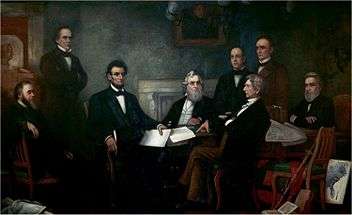
.jpg)
